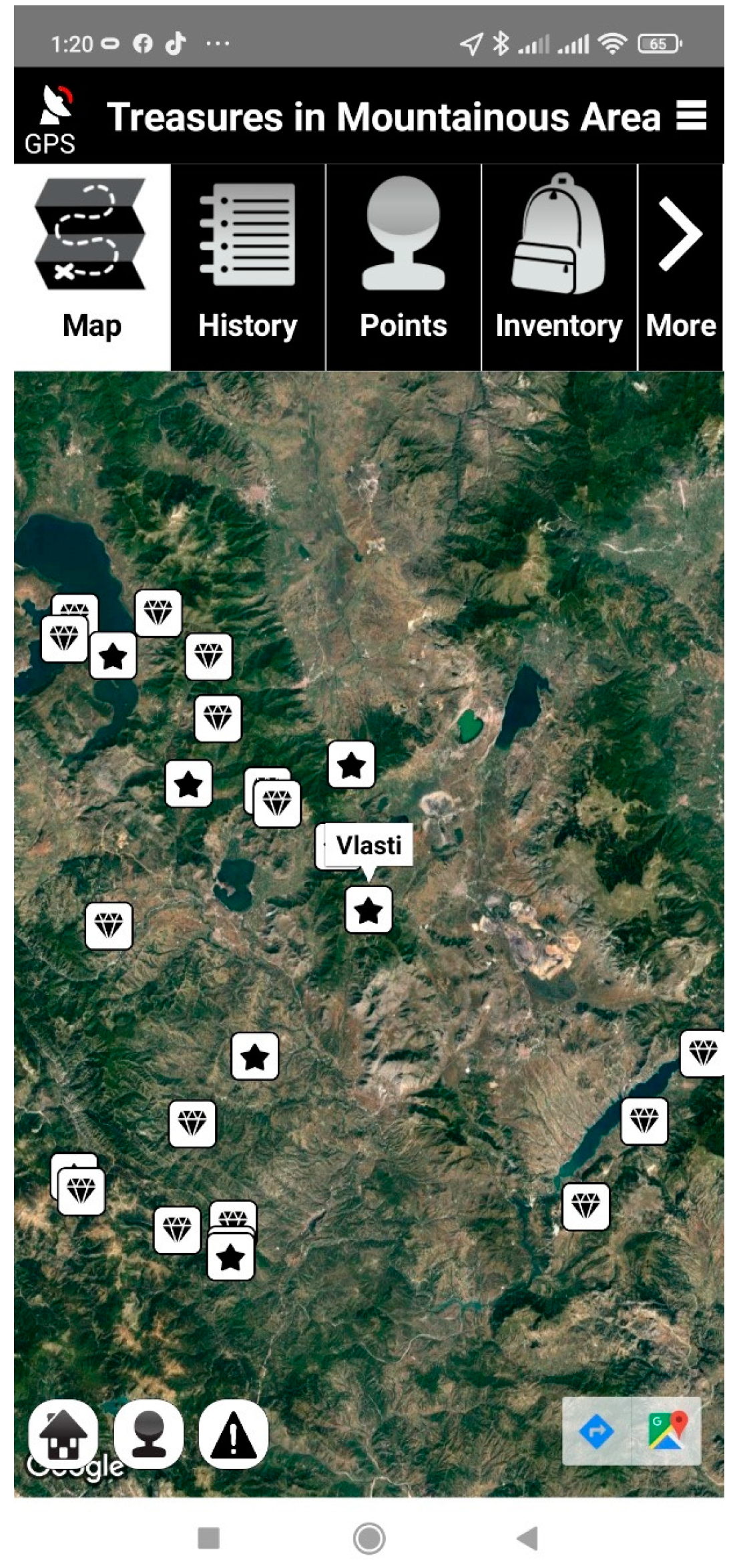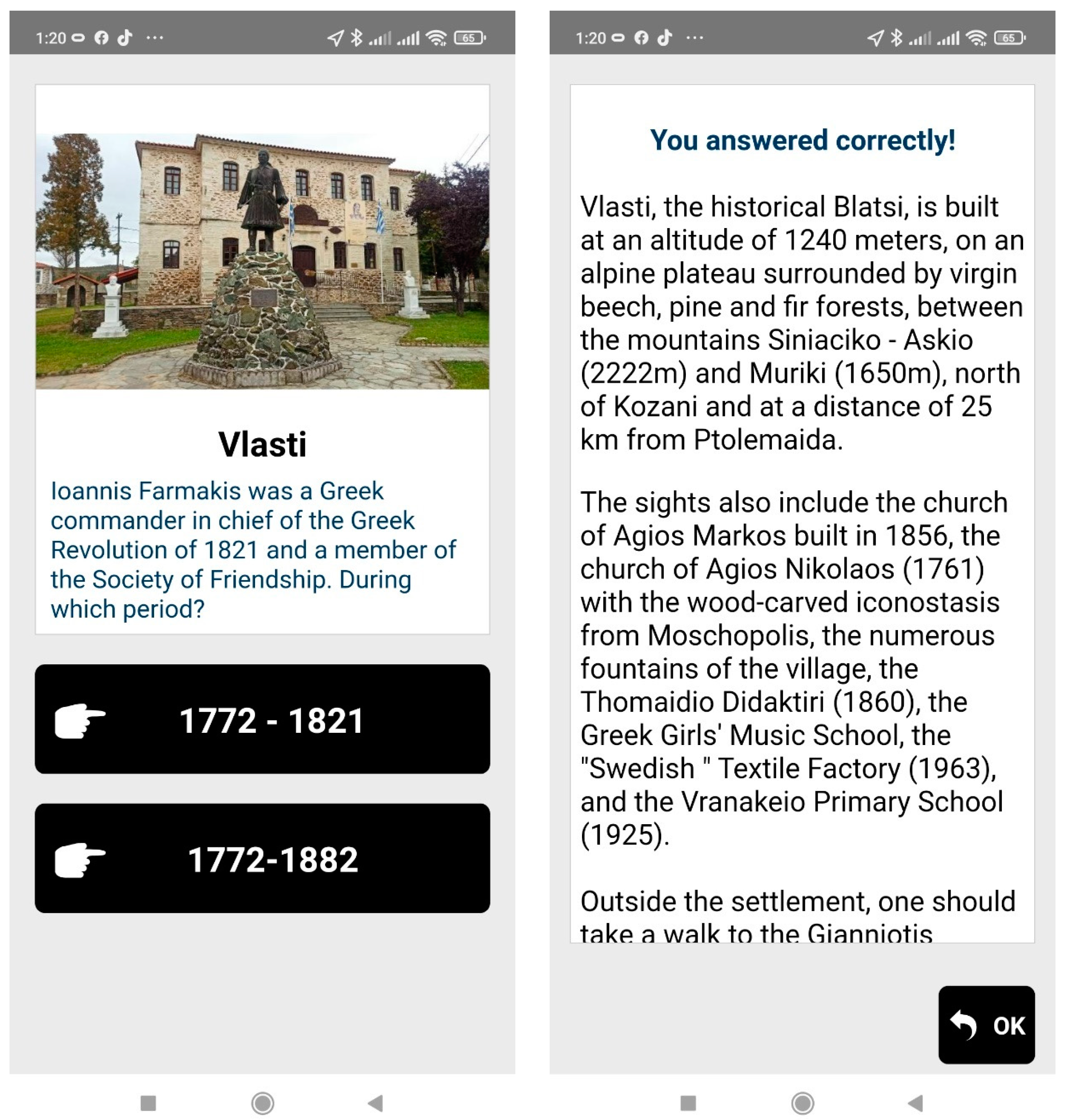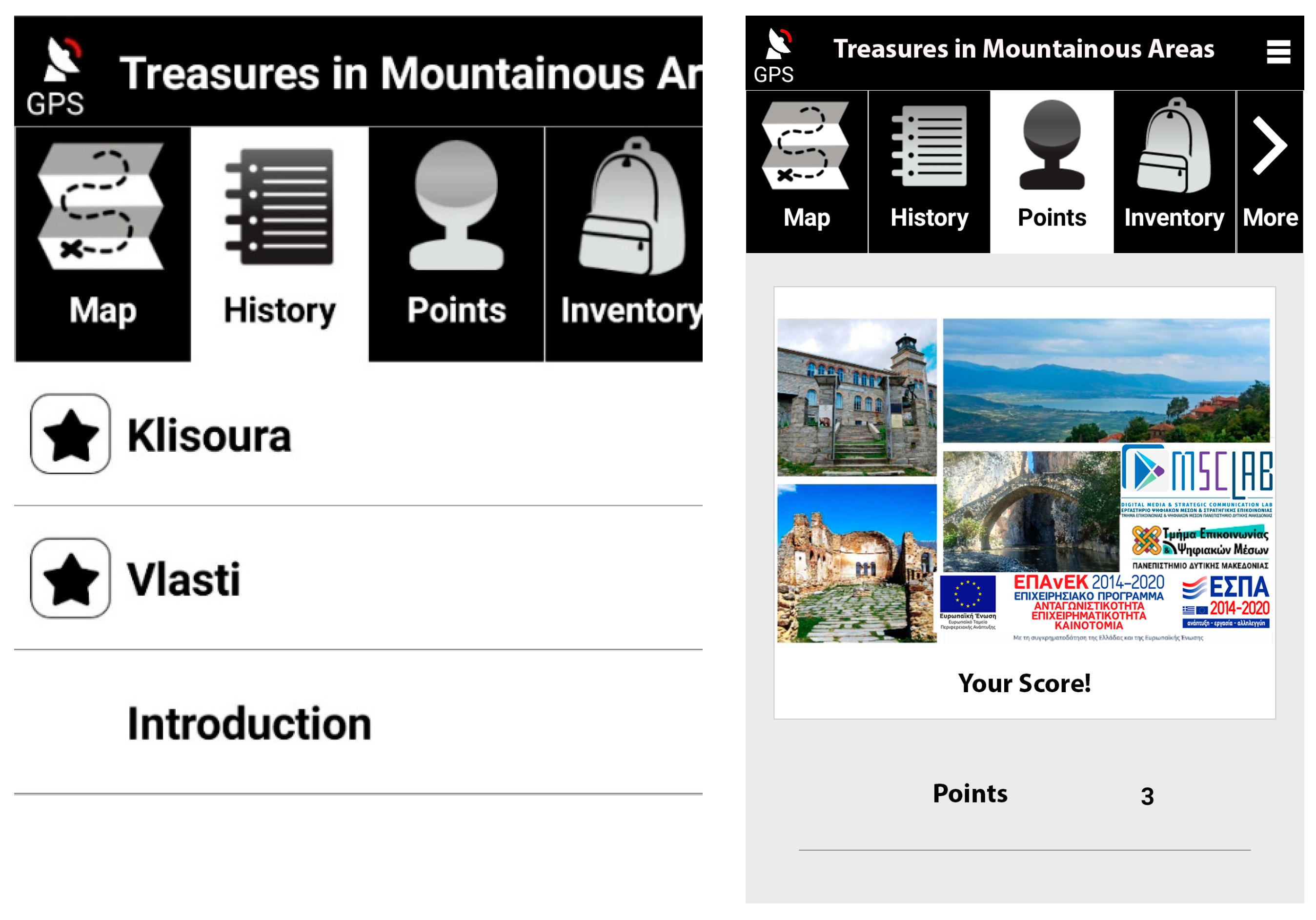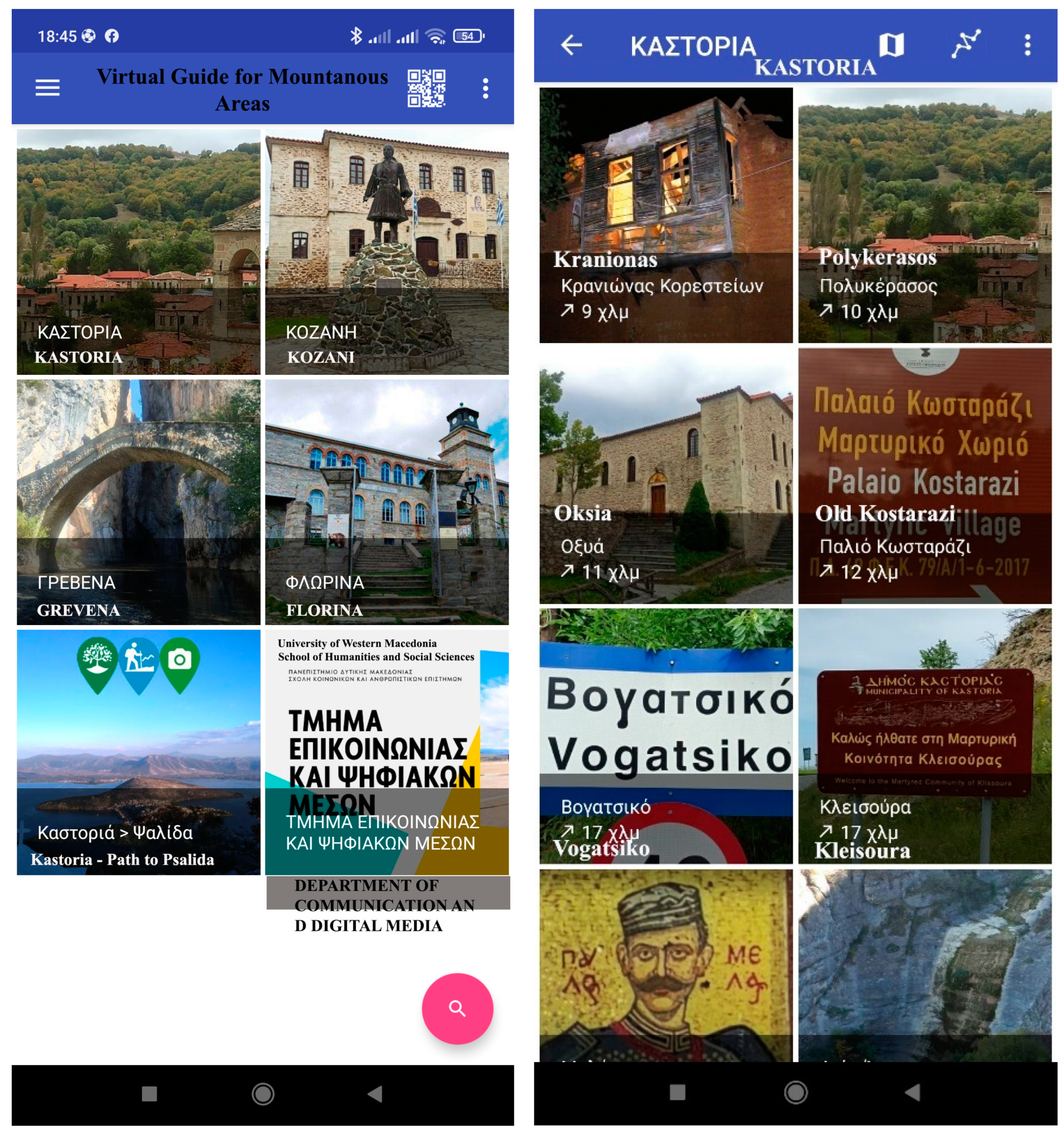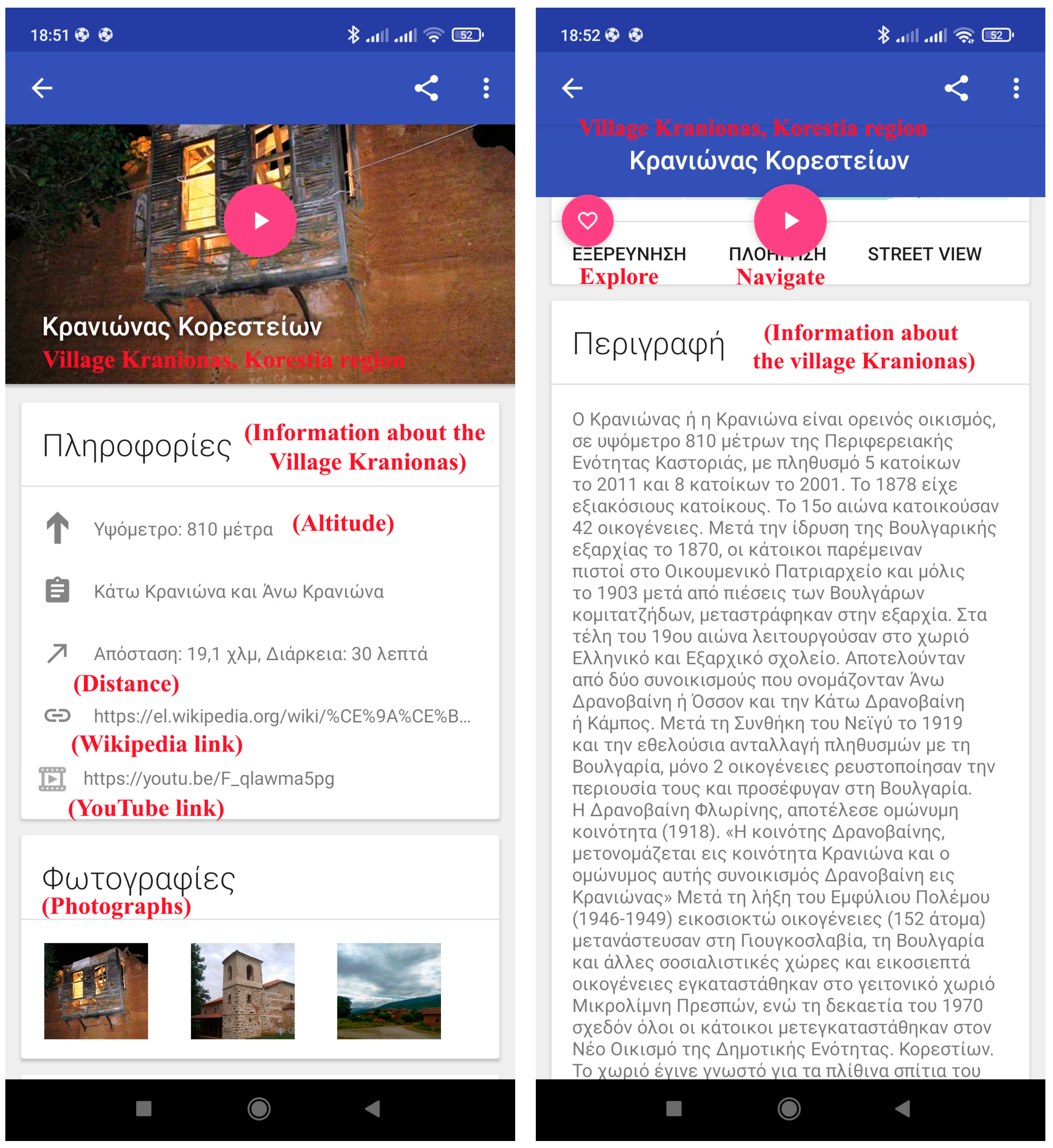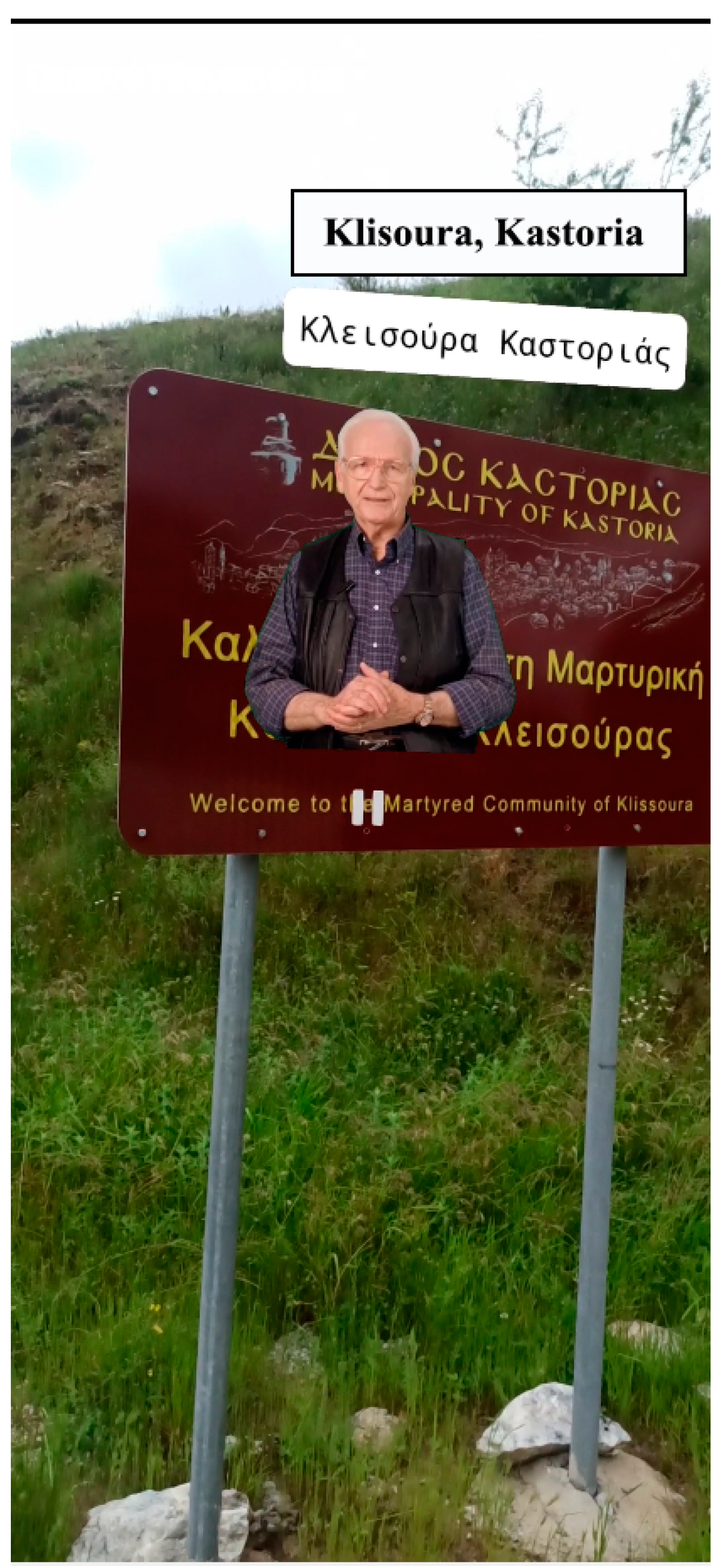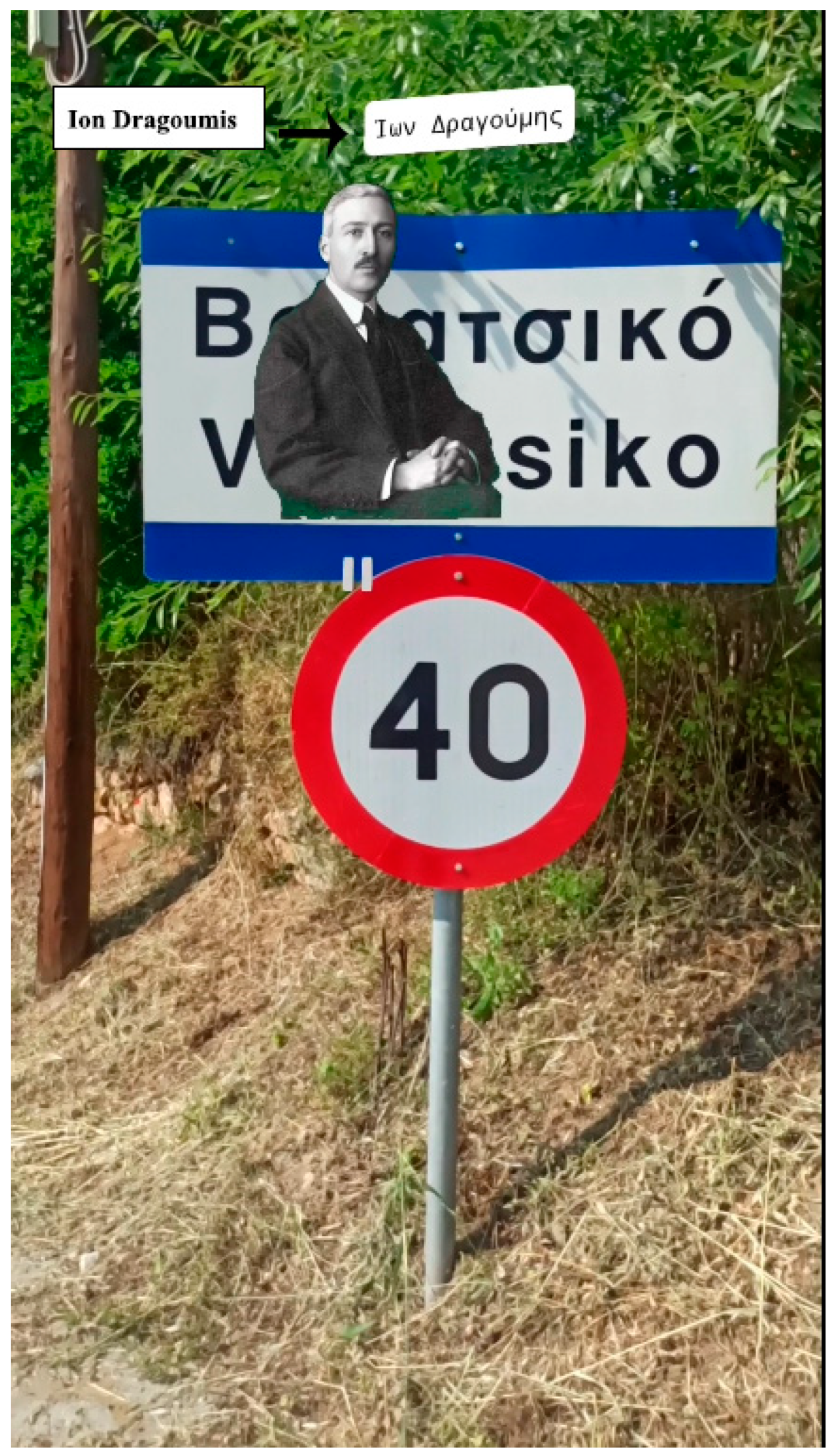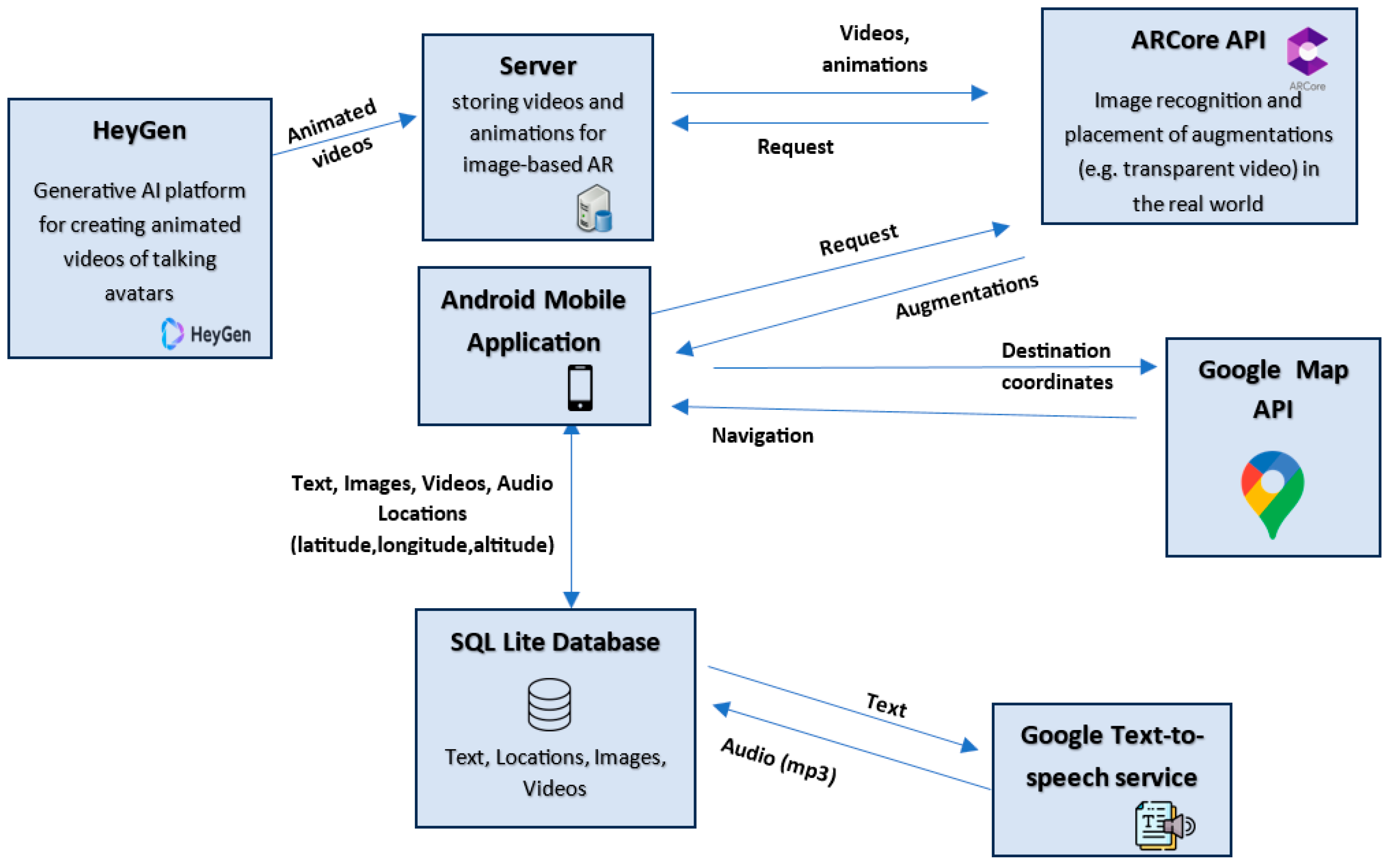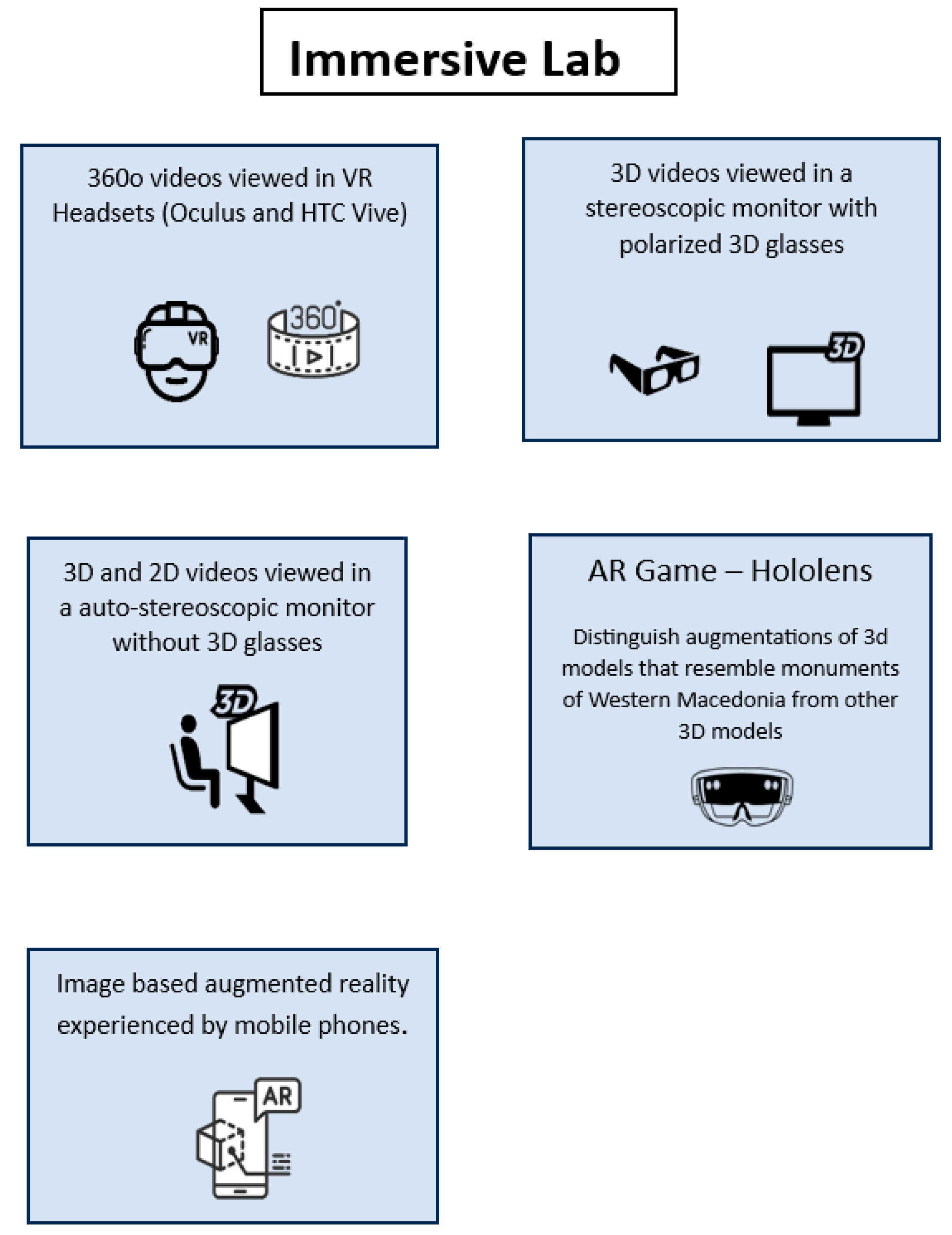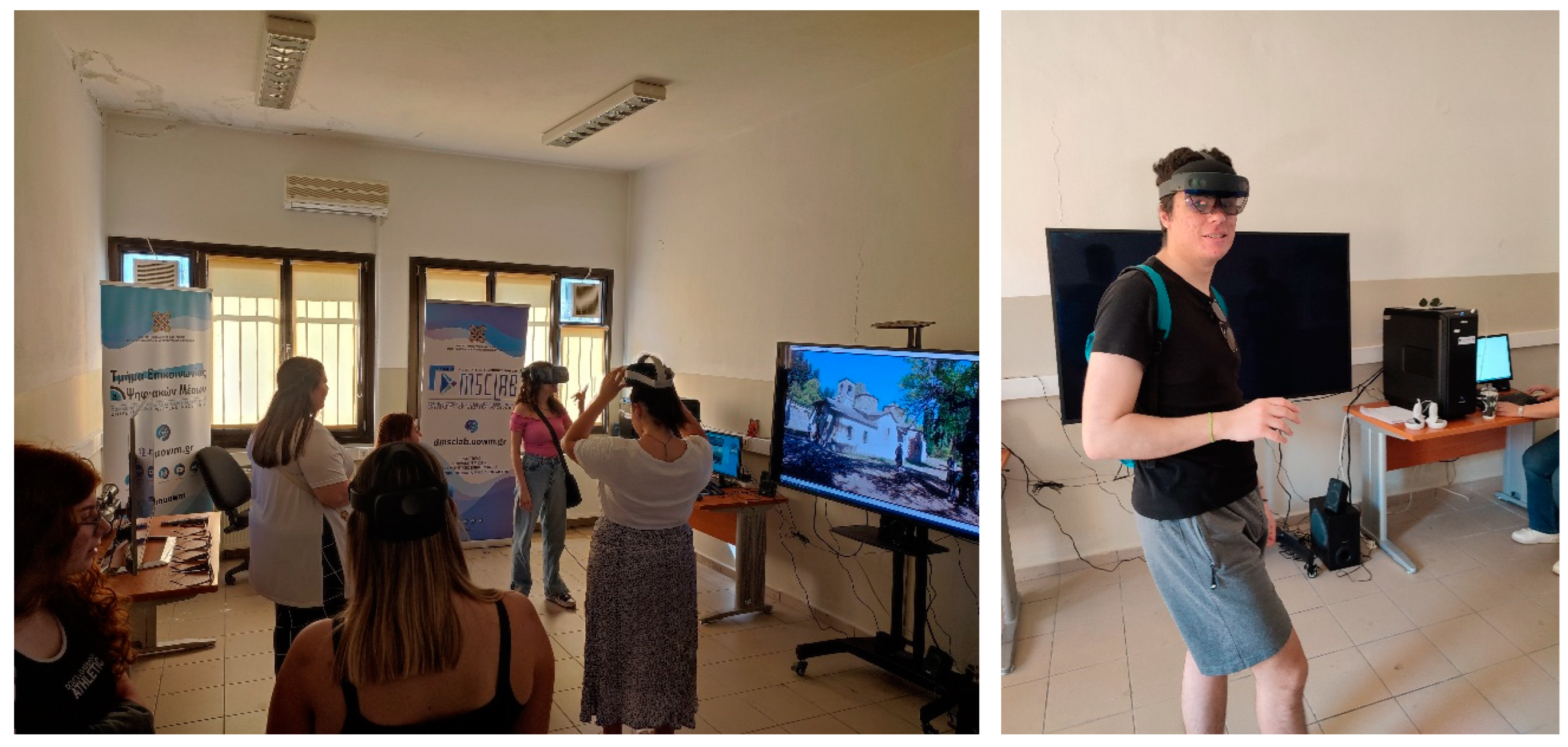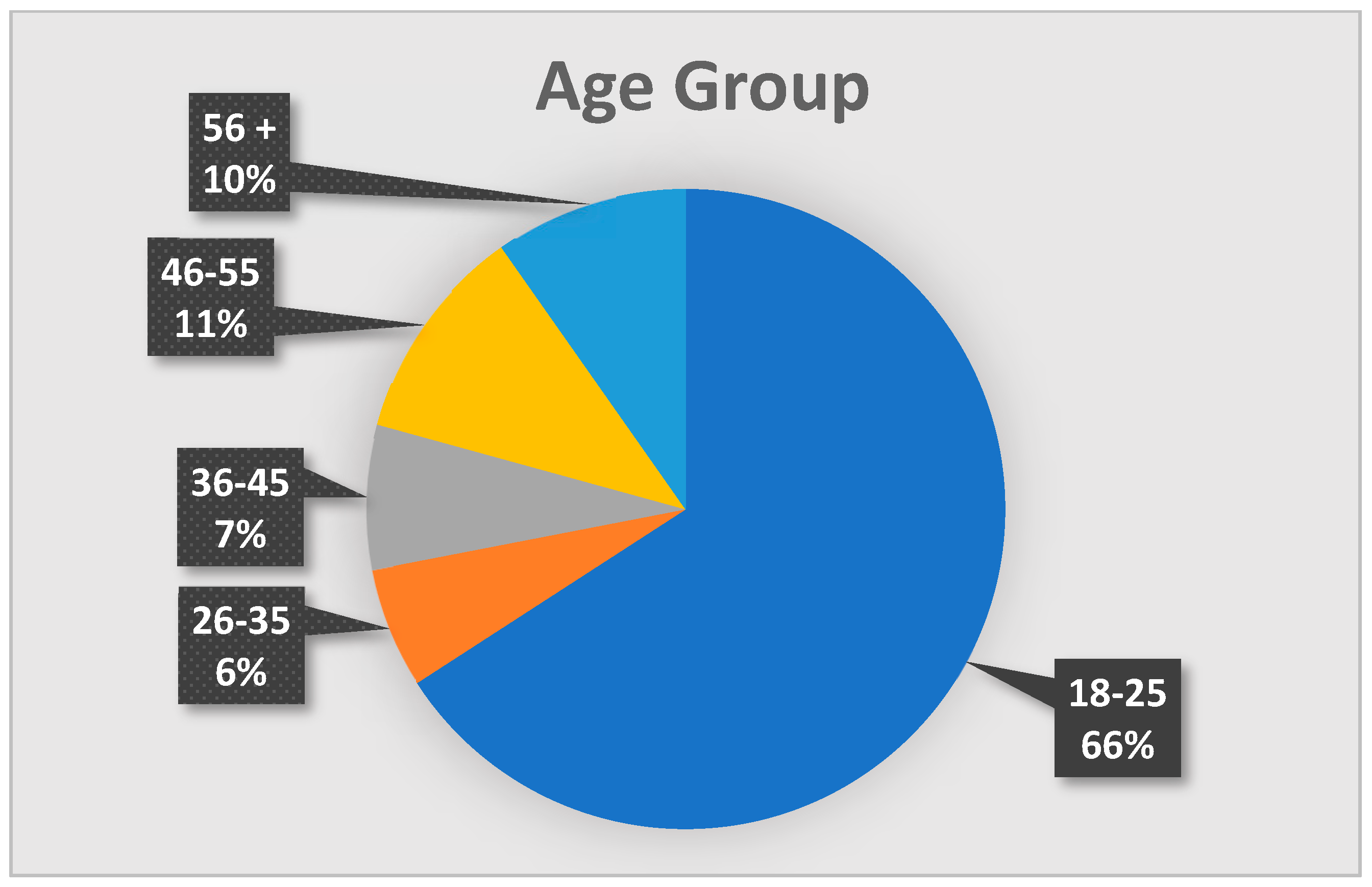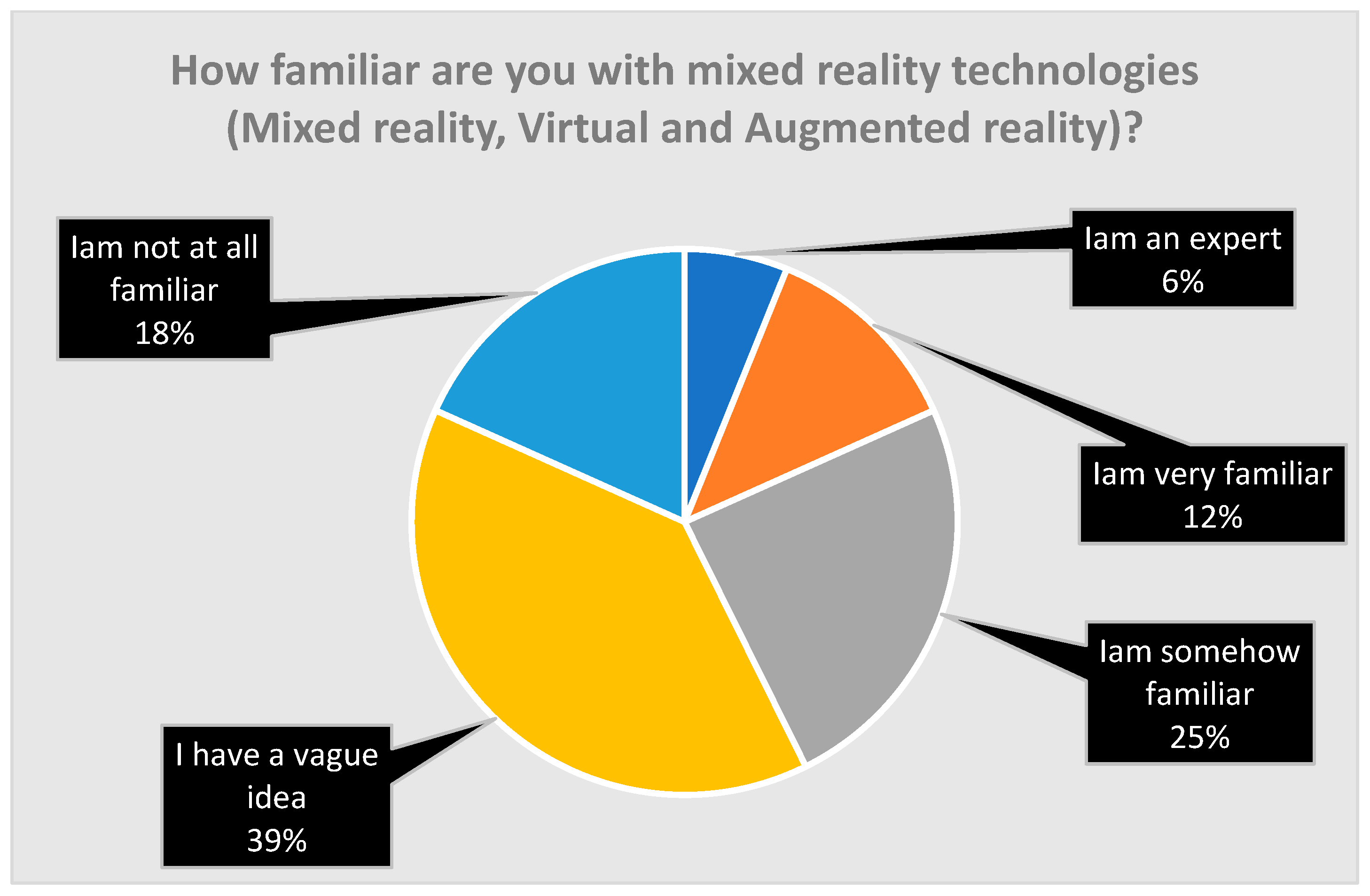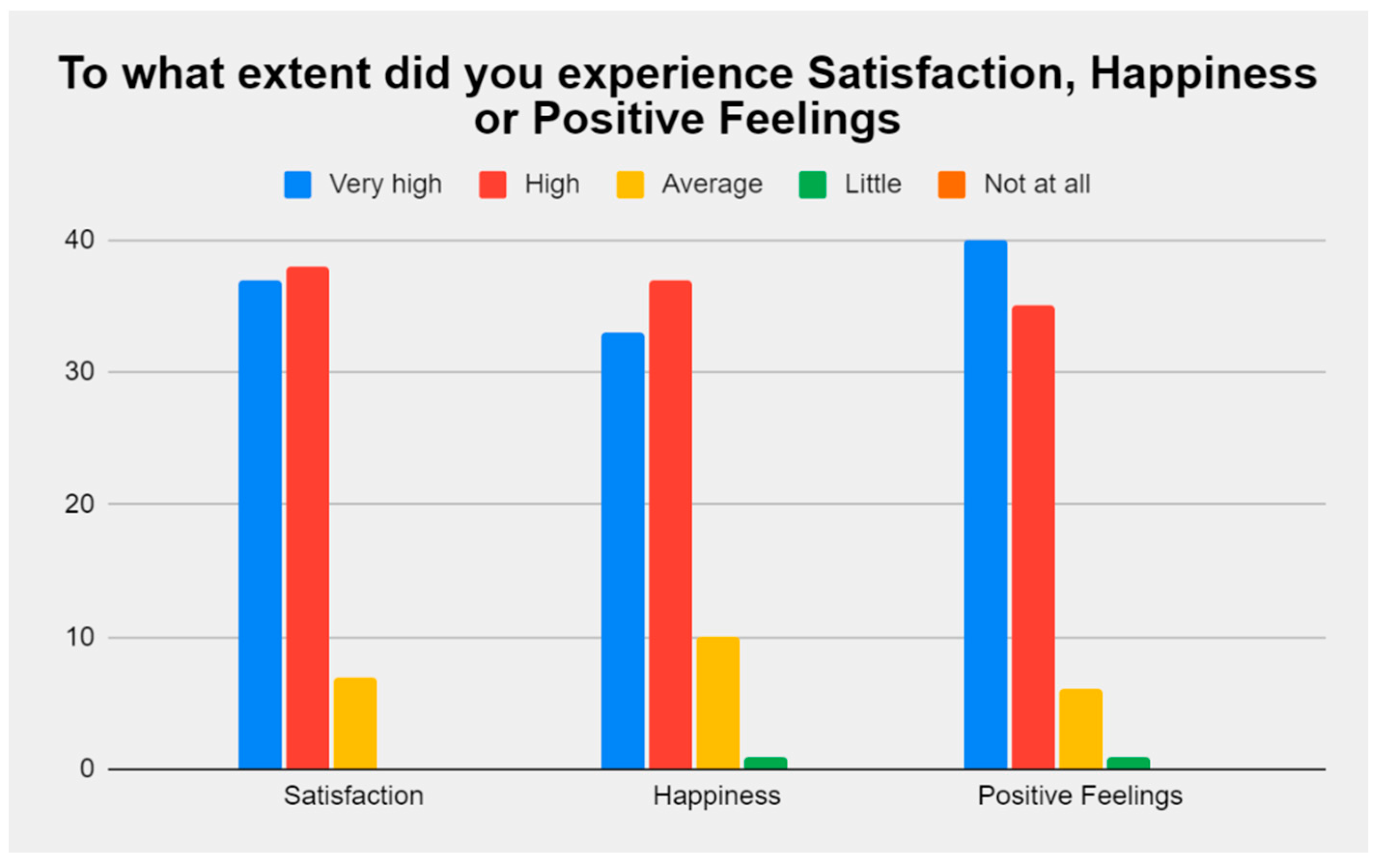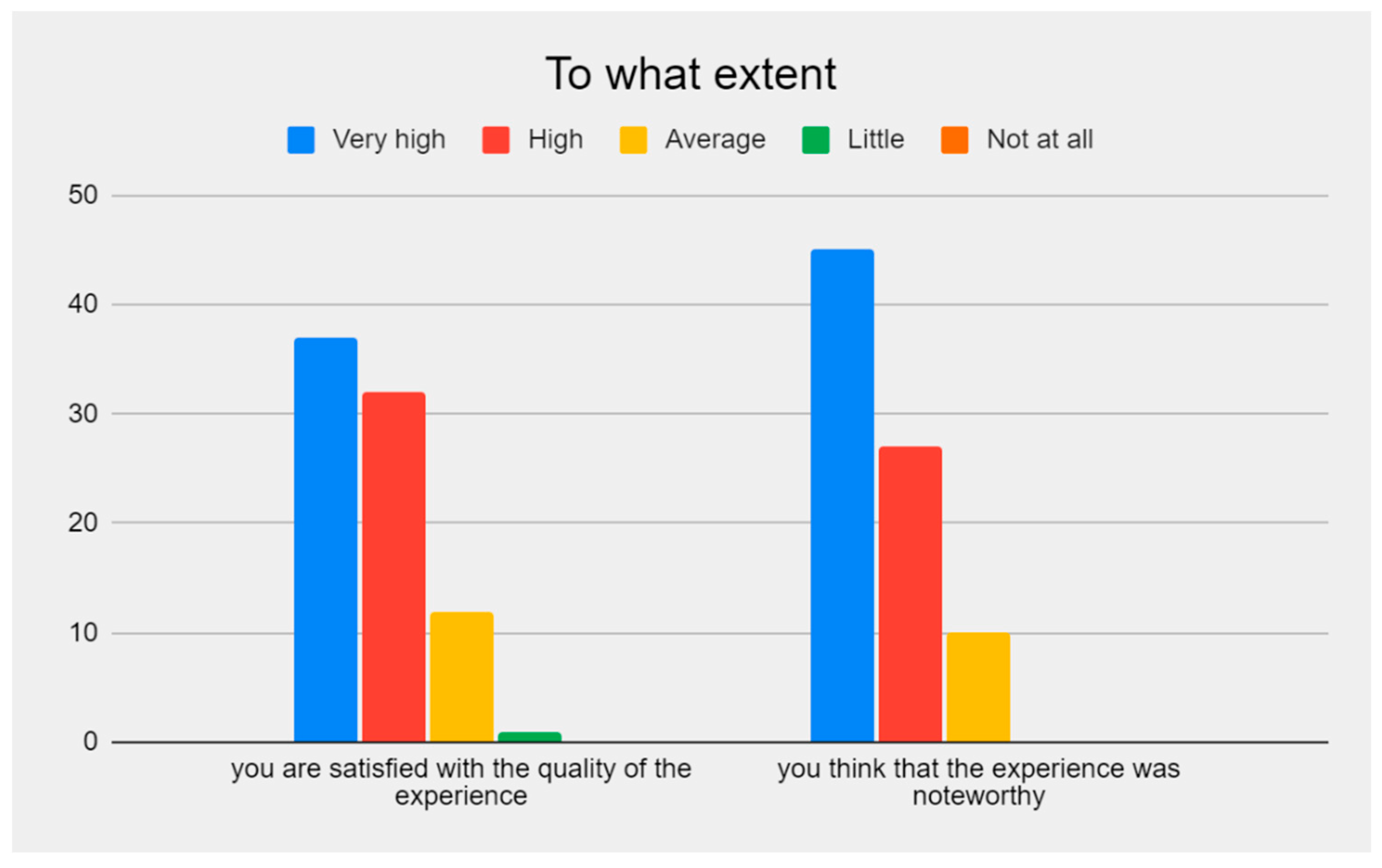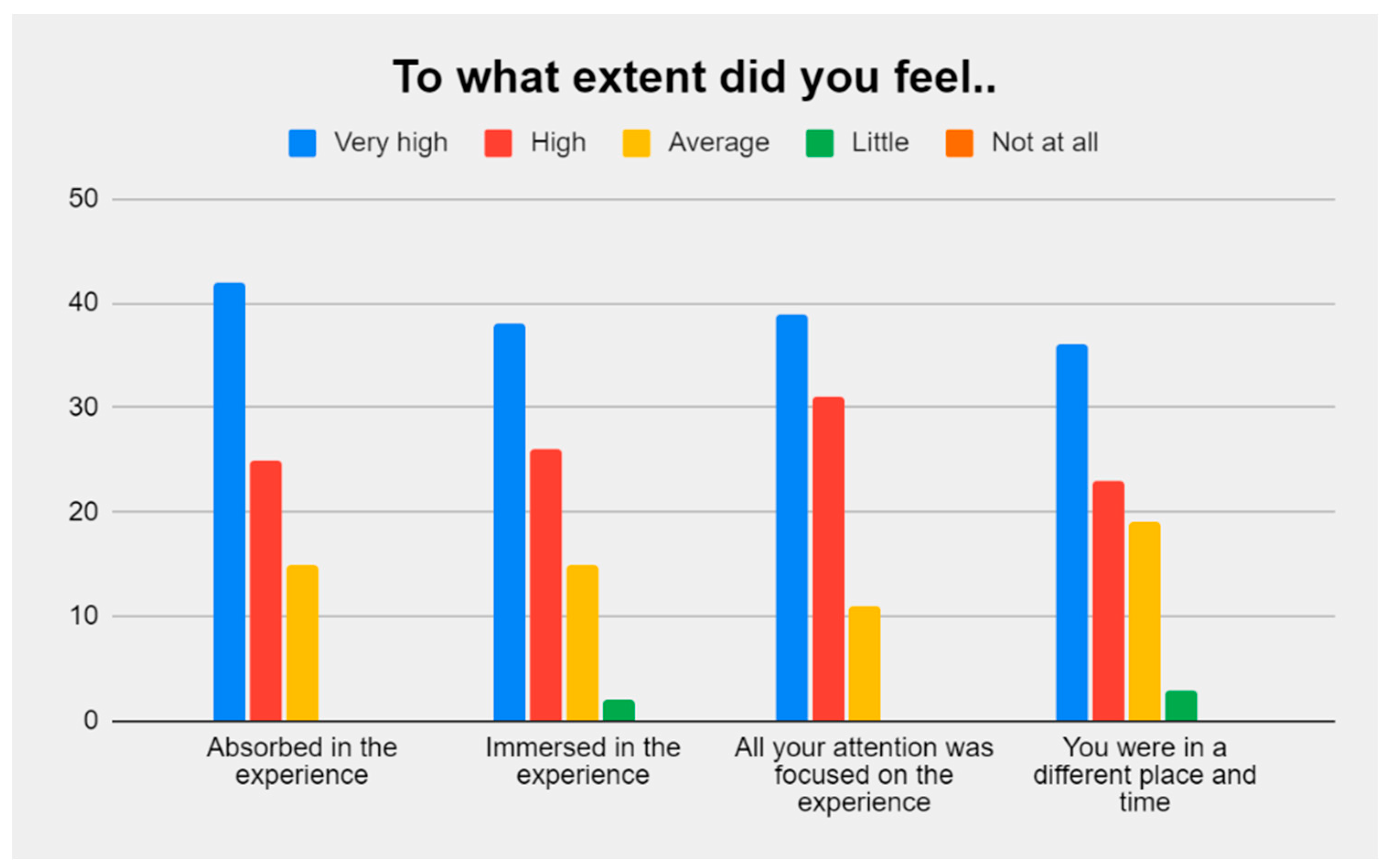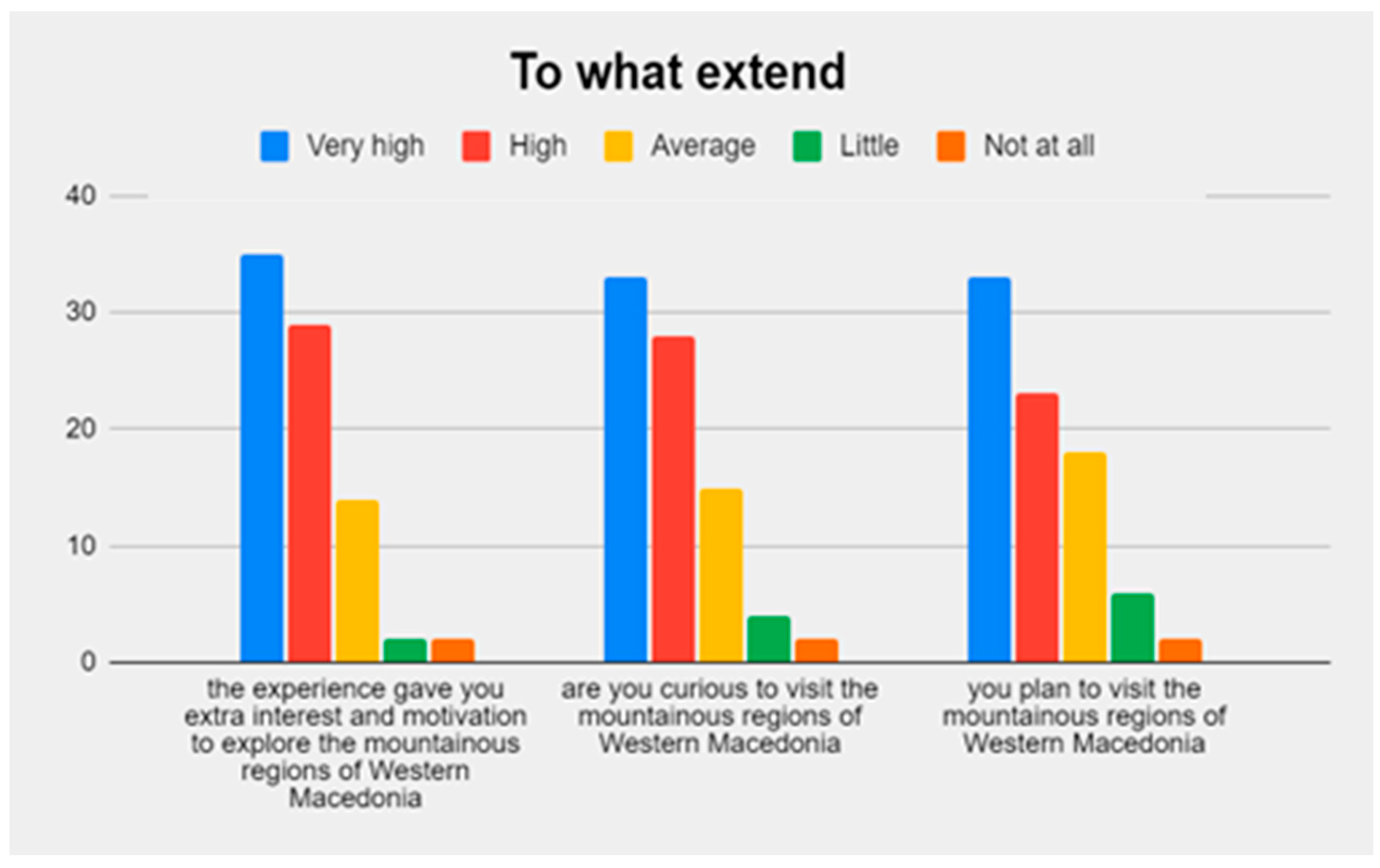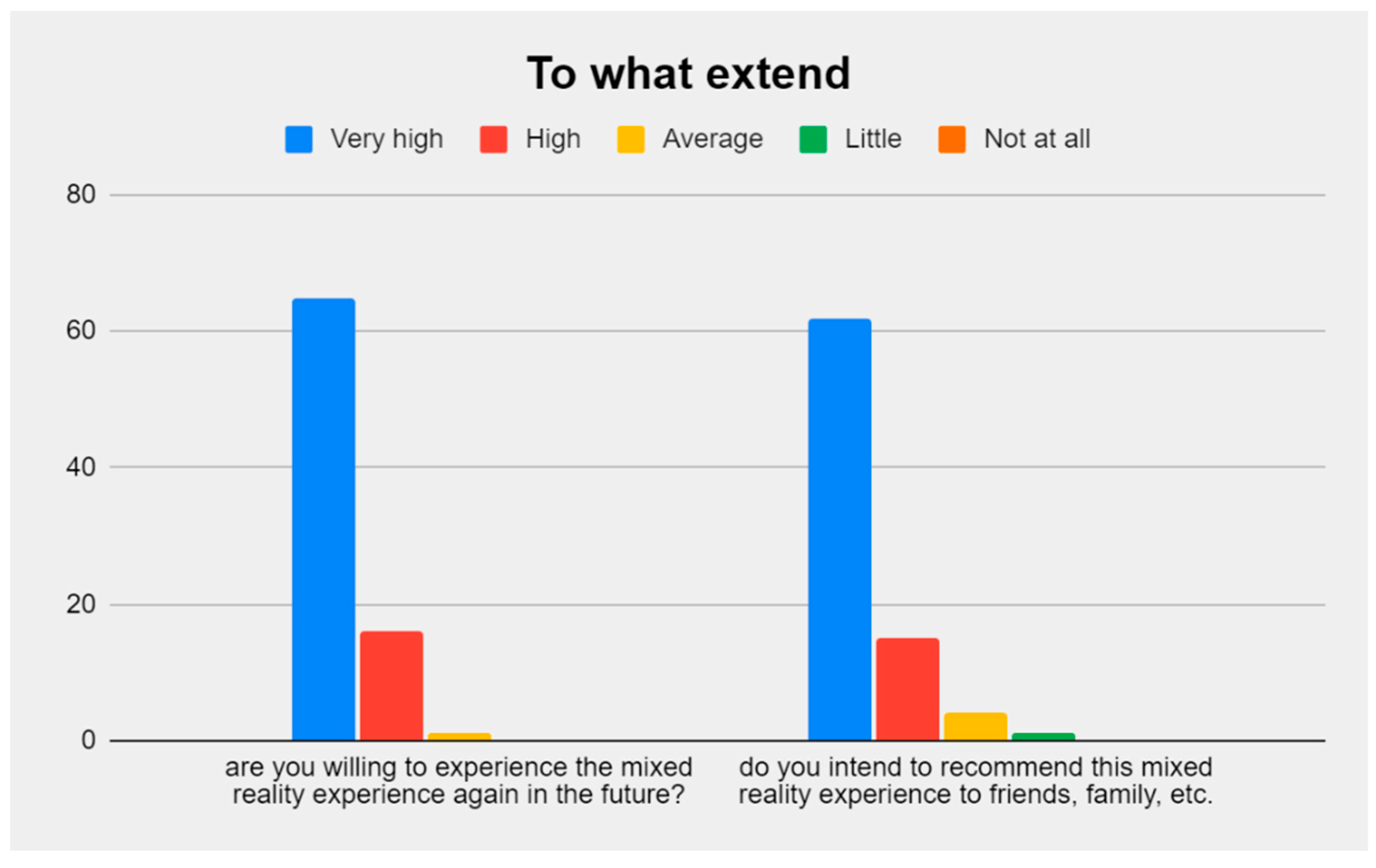1. Introduction
Mixed reality (MR) is being increasingly used in many fields for research and commercial purposes. Amongst these fields is tourism, where augmented reality is employed to enhance the touristic experience and educate visitors through applications that combine the promotion of destinations with education and entertainment. Hobson and William stated in their study [
1] that travel itself can be regarded as a secondary reality, where tourists escape temporarily. Tourists often seek to escape into simulated experiences like amusement parks (e.g., Disneyland), totally absorbed into new alternate realities [
2,
3]. It can be argued that virtual and augmented reality (VR and AR) achieve similar experiences where tourists are immersed in alternate realities [
4].
AR and VR applications that combine entertainment and education are being utilized to enhance the tourism experience and promote destinations. These applications can intensify the “presence” of the visitor at a destination [
5], and create memorable tourism experiences through game elements such as challenges, rewards, competition, and role-playing [
6]. Furthermore, they can increase visitor knowledge and awareness about a destination [
7]. By experiencing such applications, the users can gain useful information about a destination, such as its history and geography, the natural environment and its flora and fauna, tangible and intangible cultural heritage [
8], transport information, and gastronomy. Consequently, visitor satisfaction is enhanced [
9], and that in turn has a positive impact on the destination’s sustainability [
10].
Augmented reality adds a digital information layer to the real world. Augmented reality (AR) applications are situated closer to the left end of the virtuality continuum as can be seen in
Figure 1, where real environments lie on the left end and virtual environments on the right end. This space between the two ends contains various levels of mixing between virtual and real-world elements and is known as mixed reality [
11].
Researchers and academics have proposed various definitions for AR [
3]. One of the first definitions encountered in the literature was proposed by Azuma in 1997 [
12], who defined AR as 3D objects integrated into a 3D real environment in real-time, highlighting three characteristics: (a) a combination of real and virtual, (b) interactive in real-time, and (c) registered in 3D. However, this definition does not encompass all the contemporary variations of augmented reality, and it is more aligned with image-based AR where specific images are needed to register the position of the 3D objects in the real environment [
13]. The incorporation of Global Positioning Sensors (GPS) in mobile devices has opened new venues for augmented reality, resulting in a new subset of AR, the location-based or location-aware AR [
14]. Location-based AR applications relying on the geolocation capabilities of mobile devices can present to users context-sensitive digital information that is related to their surroundings [
3,
13,
15]. This section will further discuss the terms image-based (or marker-based) AR and location-based AR.
Given that AR, in the years to come after the first definition given by Azuma, evolved to include a variety of applications that blend real and virtual information, a broader and more encompassing definition of AR was needed [
16]. By the end of the 2000 decade, many studies presented AR location-based applications that integrate different forms of digital information within real-world settings, such as videos, images, audio, and texts [
15,
17]. The present study focuses on mobile location-based AR applications and coincides with the broader definition provided by Fitzgerald et al. [
16], which defines AR as including “the fusion of any digital information within real-world settings, i.e., being able to augment one’s immediate surroundings with electronic data or information, in a variety of media formats that include not only visual/graphic media but also text, audio, video and haptic overlays”.
Augmented reality can be achieved through wearable and non-wearable devices. Wearable devices include headsets and helmets, such as Microsoft HoloLens, Apple Vision Pro, and Magic Leap and non-wearable devices include mobile devices (smartphones, tablets, etc.) and stationary devices (TVs, PCs, etc.) [
18]. Wearable devices are far more expensive than mobile devices, which is why mobile AR applications have played an important role in the significant popularity AR has gained over the last decade.
Quite a few categorizations have been presented throughout the evolution of AR, and one of these is based on the technologies that enable the AR experience (i.e., wearable and non-wearable devices) while another is based on the way that the digital content is triggered. In this categorization, we have marker-based, markerless, and location-based augmented reality.
Marker-based AR (or image-based AR) works by scanning a marker that triggers an augmented experience. Markers can be images such as drawings in art museums, street signs, and book pages, as well as real-world objects like statues and bridges. When a marker is viewed through the lens of a mobile device camera or an AR head-mounted display, it will activate digital content. The digital layer of information that superimposes the real world can come in many multimedia forms, such as text, images, videos, sound, 3D models, and 2D and 3D animations.
On the other hand, in markerless AR, digital content is chosen by the users and overlaid on physical surfaces on demand (floor, table, etc.). Finally, location-based AR applications, which can also be considered a type of markerless AR, present digital media to users when they reach specific locations as they move through the physical world. In these applications, GPS sensors constantly track users’ location. Location-based AR has experienced significant growth after the advent of two popular augmented-reality location-based games, namely Pokémon Go and Ingress, created by Niantic in 2014 and 2016, respectively.
Location-based augmented reality games are currently used in several fields, such as entertainment, education, marketing, and tourism. An application can also be used to fulfill more than one purpose. For example, location-based AR games designed for tourism can be used to entertain tourists when they visit a destination, but at the same time, it can also educate them about various aspects of the destination, such as the cultural heritage and history of the place as well as aspects regarding its natural environment (e.g., mountains, rivers, wildlife). Having an experience that combines entertainment and learning about a destination is something that many tourists are looking for today, as acquiring new skills and learning something valuable while traveling is a current trend in tourism, which is especially popular amongst the representatives of Generation Y [
19]. Location-based AR games attempt to create a deeper level of engagement between the users and the destination through an experience that combines educational entertainment, storytelling, personalized features, and social interaction [
20].
Educational tourism (Edutourism) has been a trend in the global tourism industry for quite some time [
21,
22]. The main purpose of educational travel is to obtain knowledge and experience on certain topics rather than just enjoying the travel experience. Furthermore, AR and VR through wearable headsets can also promote destinations and educate individuals about these destinations before, during, and after their visit. Overall mixed reality (AR and VR applications) can be a significant asset in tourism marketing and educational tourism [
23].
This paper aims to present a holistic approach that utilizes mixed reality technologies (AR and VR) to promote mountainous areas of Western Macedonia, Greece. Western Macedonia is a region in Greece with high unemployment rates, a region that could benefit economically from an increase in tourism. Furthermore, although mountainous regions possess exceptional beauty, they receive less tourism than other destinations in Greece, which are located near the sea.
This initiative is part of a broader project called Agrotour (the Agrotour project,
https://agrotour.uowm.gr/, accessed on 10 September 2023), which aims at enhancing research and development in many areas that could strengthen the economy of Western Macedonia, such as agrotourism, smart farming, stock raising, bioeconomy and agri-food, new technologies in farming, etc.
The applications that have been developed include gamification features and aim at enhancing the travel experience by entertaining and educating the visitors.
More specifically, the paper aims to present the following:
(a) The methodology that was followed for identifying destinations in the mountainous regions of Western Macedonia that could benefit from touristic promotion.
(b) Three location-based applications with gamification features. Through these applications, the users visit places, and experience multimedia content when certain locations are reached. Users also gather points, virtual objects as well as prizes when certain tasks are accomplished. Various technologies have been used for developing these applications, which will be described in detail. Furthermore, by presenting these applications and the methodology followed to create them, the paper also aims to provide ideas and, to a certain degree, technical information for those wishing to develop similar applications.
(c) A mixed reality lab where visitors can experience 3D, virtual, and augmented reality content related to the mountainous areas of Western Macedonia, Greece. Many visitors have visited the lab so far, and the paper will also present evaluation results from these visits.
The contribution of this study to the existing literature is the presentation of a holistic approach that utilizes a range of AR and VR technologies in combination for touristic promotion and education. These technologies include augmented reality location-based games, an AR mobile application with virtual guides that combines location-based and image-based AR, and an immersive lab with content that can be viewed using virtual and augmented reality headsets as well as content that can be viewed through stereoscopic monitors. The equipment for producing the content for these devices is also presented. It is worth mentioning that most of the research initiatives encountered in the literature focus on specific applications that are either VR or AR rather than several AR and VR technologies that are used in combination. This is evident from literature reviews [
3,
24] that examine both VR and AR applications in tourism. For example, in the critical review by Wei [
24] amongst the 60 papers that were retrieved and reviewed, 33 concerned VR, 25 AR, and only 2 combined both technologies.
Furthermore, this paper briefly presents how mobile AR games for educational tourism can be developed using an open source platform that is accessible and user-friendly to everyone who is interested in developing similar applications. This development platform is Taleblazer, an AR platform developed by MIT, a platform that is suitable also for people with no prior experience in programming. Therefore, it is expected that the paper will also provide ideas and guidance to people who do not have technical expertise and who are interested in developing location-based games for educational purposes.
Another contribution of this initiative is the use of the emerging generative artificial intelligence (AI) platforms for rapidly producing animated content for AR applications. More specifically, virtual talking characters were created and embedded in one of the mobile AR applications. Such a task typically requires both time and expertise, but generative AI tools can aid in producing such content fast and without any particular skills.
2. Related Work
There are many initiatives where virtual and augmented reality are used to enhance the destination experience by entertaining and educating the public. In order to spot these research initiatives, the literature was explored by searching Scholar Google and by conducting a bibliometric analysis using VOSViewer 1.6.20 [
25] and publications from Scopus. The keywords used were virtual reality and augmented reality in tourism research. However, more focus is given to AR and more specifically location-based AR since a large part of the current paper concerns location-based augmented reality in tourism.
Starting from various initiatives that concern location-based AR games, the authors in [
19] analyze how gamified augmented reality experiences impact tourist attractiveness. Their study focuses on the city of Bydgoszcz, which lacks the most popular attributes of sun, sand, and sea, a similar case to the Western Macedonia region in Greece. Their research aimed to analyze the potential of increasing the number of visitors in the city by creating a location-based AR game. The authors also explored whether the game created a memorable experience for the visitors, an experience that would bring them back to the city. The responses received using a survey led to the conclusion that a location-based mobile game using gamification techniques and AR is a memorable experience, and the development of such a game and its introduction on the market would increase the potential of foreign tourism in the destination.
The authors of [
7] research through Structural Equation Modeling (SEM) the impact of location-based AR games on the users’ intentions to visit a touristic destination, the role that gained knowledge plays in the experience, and factors driving the adoption of AR games. The study revealed that knowledge gained during gameplay has a statistically significant impact on intentions to visit.
To promote film-induced tourism in Macau, China, the authors of [
26] proposed an AR application called “IfilmAR-tour-APP”, which is a location-based AR mobile tour system related to film characters. The application provides film-related information (e.g., film shooting sites and transport to the attractions) as well as emotional attachment with film celebrities. Macau is a place where many film productions take place and this application is intended for tourists that visit film sites.
Location-based AR games are also used extensively in cultural heritage communication and education as this field holds an important role in tourism since many tourists are interested in exploring the history and cultural heritage of the places they visit. Heritage tourism is primarily concerned with the exploration of tangible (material) and intangible (immaterial) remnants of the past [
27].
In the recent literature, there are many examples of initiatives that utilize the power of AR to present information regarding the history and cultural heritage of a destination.
For example, in [
28], a mobile application called Korat Historical Explorer was developed and evaluated. Korat is the largest province in Thailand with many historical sites including more than 2000 temples. The application has three important AR usage modes consisting of (1) an AR map mode used for looking at the map in the form of print media to display 3D simulations of 10 tourist attractions in Korat, (2) AR landmark mode used for viewing actual objects in their actual locations such as ancient art paintings and mural paintings to view relevant 3D images, and (3) AR direction mode used for leading the user to the important points of the tourist attractions.
Museums and archaeological sites are also entities that employ AR to transmit information in a more engaging way. In these initiatives, when the user gets close to certain locations, the real environment is enriched with digital information, which can be in many multimedia forms such as text and sound, digital stories, animations, 3D reconstructions of monuments, etc.
For example, in [
29,
30], the researchers explored the enhancement of the visitor experience in outdoor archeological sites and indoor museums with the use of augmented reality technology. These AR applications managed to educate a broad and non-specialized audience with historical and archaeological content in the form of 3D virtual reconstructions. The visitors of these archaeological sites and museums may visualize these reconstructions by looking through the camera lens of their mobile devices at specific targets of the real world.
Jiang et al. [
31] examined the efficacy of AR for enhancing the memorability of tourism experiences (MTE) at the heritage site of the Great Wall of China, using a smartphone app, equipped with four interrelated AR heritage tourism experiences. In [
32], an AR location-based application that added a layer of 3D models of historical buildings in the real world was created. The 3D models presented how these constructions were in their past state. The authors of [
33] developed an AR game called “The buildings speak about our city”, which is a combination of location-based and marker-based augmented reality. The game aims to motivate primary school students to discover the buildings of tobacco warehouses in a city in western Greece, which have historical, architectural, and cultural value, and explore their relationship with the city’s economic and cultural development.
Location-based AR can also be utilized in interior spaces (e.g., museums) where GPS signals are absent with the use of beacons and other tracking devices [
30,
34].
Furthermore, AR location-based games often harness the power of storytelling to transform an AR tour into a more exciting and engaging experience. Storytelling is known to be a powerful communication method. Storytelling is deeply embedded in human learning, as it provides an organizational structure for new experiences and knowledge [
35]. People can mentally organize and memorize information better if it is communicated through stories. Any advancements in media technology that enable people to convey stories in new and innovative ways can have a profound impact. Storytelling is also an effective method of education and instruction. Stories can contain lessons, codified bits of wisdom that are passed on in a memorable and enjoyable form [
36].
One of the earliest attempts of AR location-based games that utilize storytelling to entertain and educate tourists is REXplorer [
37], an application created for tourists visiting the town of Regensburg, in Germany. REXplorer players encounter virtual characters and, more specifically, spirits of historical figures during gameplay. These virtual characters relate to historic buildings. The AR game aims to make the task of learning history a fun process. The spirits interact with the users, prompting them to go on quests at specific locations within the city center. By performing these quests, the players indirectly explore the historical city center and learn history in an entertaining and engaging way. Of course, there are also plenty of recent examples where AR and storytelling are jointly utilized in tourism to educate the public about a place’s history and cultural heritage [
38,
39].
Furthermore, since this paper also utilizes virtual reality (VR), it is worth mentioning that there have been many studies in the past that research the effects of VR technologies in tourism promotion where it has been documented that VR can be used to promote a destination by generating a sense of presence. For example, in [
40], the authors present an AR/VR application that presents and promotes shore excursions on cruise ships. The study investigated the effectiveness of different media—head-mounted display (HMD) or computer—used to view 360-degree tourism promotional videos as well as the impact of different information sources featured in a VR tourism video on destination image formation and intention to visit. The findings of many studies suggest that virtual reality can be an effective medium for tourism promotion (e.g., [
40,
41]).
The idea of “virtual portals” is presented in [
42] for outdoor archaeological sites. “Virtual portals” is an idea inspired by many TV series, movies, and video games. Through these portals, the users perform transfers (or jumps) between the real world, AR, and VR reality. The authors explored the possibilities of a mixed reality that contains “shortcuts” (virtual portals) for performing “time travels” to bring the user from the real environment of the present to the virtual environment of the past.
And there are many more examples where VR is utilized for tourism promotion and such examples can be found in related literature reviews (e.g., [
3,
43,
44]). Yung and Khoo-Lattimore [
3] provide a systematic literature review on virtual reality and augmented reality in tourism research, while other reviews focus on either the use of VR or AR in tourism exclusively. For example, Beck et al. provide a state-of-the-art review on virtual reality in tourism [
44], Theodoropoulos and Antoniou [
43] provide a systematic review of VR games in cultural heritage, while Jingen and Elliot provide a systematic review on AR in tourism research [
45]. In the Yung and Khoo-Lattimore review [
3], virtual worlds were the most common focus (39% of the studies), and all studies of virtual worlds were based on the Second Life virtual world. The most common focus was studying the destination marketing potential of Second Life. Furthermore, the applications used for the enhancement of the touristic experience were exclusively AR applications. The authors argue that this could be explained with the higher mobile nature of AR when compared to VR, which typically demands the user to be stationary and requires more processing power. Similarly, Moro, Rita, Ramos, and Esmerado argue in their study [
46] that although both AR and VR are progressively becoming more common in tourism experiences, VR is commonly designed as the basis of an experience, whilst AR is used to supplement an existing experience. In the study of Roman et al [
47], more than 87% of the respondents that took part in a survey believed that VR tourism cannot substitute real-world tourism in the long run. However, the authors argue that VR tourism will be more beneficial for the citizens of developing countries who face difficulties in traveling to developed countries due to economic as well as other reasons (e.g., visas). Furthermore, virtual sightseeing may also constitute an alternative for people who cannot travel due to disabilities or other health conditions.
Moreover, the authors of [
45] claim that while virtual reality might be a threat to travel and tourism as a potential substitute, augmented reality allows users to interact with the real environment that could potentially enhance visitors’ experience. On the other hand, one of the findings of the Beck et al. literature review on virtual reality in tourism [
44] is that research in this field has most commonly examined the pre-travel phase, using VR as a marketing tool for promotion and communication purposes and therefore end up investigating variables such as travel planning, behavioral intentions, or attitude. Study results suggest that VR, regardless of whether it is non-, semi-, or fully immersive, can positively influence the individual motivation to visit a place. Similarly, several studies that were analyzed in the review conducted by Yung and Khoo-Lattimore [
3] found that the engagement and involvement participants felt when interacting with VR led to increased positive feelings toward the destination (e.g., [
48,
49,
50]).
At this point, it has to be said that initiatives that combine both AR and VR are rather rare. The ArkaeVision project [
51] is such an example that utilizes both AR and VR but also storytelling and gamification. More specifically, ArkaeVision introduces a game-like exploration of a 3D environment, virtually reconstructed, with elements of digital fiction and engaging storytelling, applied to two case studies: the exploration of the Hera II Temple of Paestum with virtual reality (VR) technology, and the exploration of the slab of the Swimmer Tomb with augmented reality (AR).
As far as education in tourism context is concerned, findings are contradicting amongst studies. In [
44], it is stated that VR research in tourism in an educational context is rare, and there is a need for such VR applications. On the other hand, in the systematic review conducted by Yung and Khoo-Lattimore [
3], VR and AR research in tourism education is found to be the second most common category.
3. Materials and Methods
As mentioned in the introduction, this study aims to present an approach that utilizes a range of mixed reality technologies (AR, VR, and stereoscopic technologies) for promoting mountainous areas of the region in Western Macedonia, Greece, areas that do not benefit from tourism as much as other places in Greece that are located near the sea. Furthermore, the mountain locations and villages of Western Macedonia may also be missed by tourists since more known places, such as the four municipality cities of the region (Kozani, Kastoria, Florina, and Grevena) are bound to attract the largest percentage of tourists visiting the area. Thus, the project’s mission is the promotion of the mountainous destinations through mixed reality applications and games that would present to the visitors the most interesting locations and educate them about their history, cultural heritage, and the natural environment.
The project has four phases: Phase (1)—identifying the mountainous villages and sites of historical, cultural heritage and natural environment interest that can be part of application scenarios (AR games and mixed reality experiences), Phase (2)—designing and developing AR games that will intrigue users to visit the places, and learn important information about the areas, Phase (3)—creating an immersive lab for destination promotion and education, a lab where visitors can experience mixed reality content, and Phase (4)—evaluating the approach.
Regarding the first phase, the places that would be included in the augmented reality games would have to be identified. Western Macedonia is a region in the northwestern part of Greece that consists of 4 prefectures, Kozani, Grevena, Kastoria, and Florina. This large region has 486 cities, towns, and villages. Thus, the places and tasks that would be included in the AR game scenarios needed to be methodically determined. To select the places in the mountainous areas, a ranking method was developed that is based on data extracted from the relevant Wikipedia page articles for each of the 486 destinations. Page views were used as an indicator of the attractiveness of the destination and thus these were collected for candidate places during the same period of approximately a month’s time (3 February 2022 until 2 March). Additional data related to altitude, population, and type of destination were also collected. The method provided an initial selection of mountain locations that are in the top ranks of the 486 destinations.
Three AR applications/games have been developed in order to prompt the users to visit a number of destinations in the region, and to educate them about different aspects of the destinations, such as historical facts, cultural heritage (monuments, etc.), the geography, and the natural environment.
To decide on the technologies that would be used for creating the AR games, the related literature as well as websites with software solutions or software reviews were investigated. It is worth mentioning that members of the project team have investigated authoring tools in the past, and performed a comparative analysis between tools, and the results of this research are presented in a previous publication [
52]. Members of the team also created AR educational games for cultural heritage and evaluated the impact of these games [
53,
54,
55].
Therefore, drawing from past experience, two of the AR games were built using Taleblazer
http://taleblazer.org/, accessed on 1 September 2023), an open platform for developing location-based AR games for outdoor and interior spaces. Taleblazer is a product of the Massachusetts Institute of Technology (MIT). Taleblazer has a visual block-based programming environment similar to Scratch, a well-known product of MIT for introducing young children and novices to the basics of algorithmic thinking and programming. Furthermore, Taleblazer produces AR games that are available on both Android and IOS mobile devices.
Taleblazer was chosen for its simplicity in rapidly creating AR educational location-based games. As already mentioned, Taleblazer is suitable for people with no programming experience as long as they are willing to learn the basics of programming through the visual blocked-based programming environment that is suitable for beginners. Thus, the applications developed in this study can act as an example to people who wish to create similar games.
In these applications, the users are prompted to visit locations, be educated about these locations through information in multimedia form (text, images, and videos), answer questions, gather points and virtual objects, and receive prizes. The first application covers the whole region of Western Macedonia, and the second one the prefecture of Kastoria where the Digital Media and Strategic Communication laboratory of the Department of Communication and Digital Media is situated.
However, although Taleblazer can produce reliable location-based games, there are some features that cannot be achieved through this online platform. One of the features that cannot be achieved is augmentations that can be seen through the lens of the cameras of mobile devices (e.g., 3D graphics and animation). This feature is quite popular in AR applications and games, and it is amongst the features that impress users the most. Therefore, to overcome the lack of this feature in the first two applications, a third application was also created. The third application is a mobile application for Android devices developed using Android and ARCore (
https://developers.google.com/ar, accessed on 1 September 2023) SDKs.
These SDK solutions were chosen for creating the third application, which would also incorporate 3D graphics and animation augmentations. This application utilizes both location-based and image-based AR. In the same fashion as the other two games, the users are prompted to visit places and get informed about the history and cultural heritage of these places. However, this time, information is often delivered through virtual characters. These are characters that act as guides for providing information to the tourists but also important historical figures that have lived in the region and characters from Greek mythology that come to life to tell stories to the users.
As mentioned in
Section 2, storytelling is a powerful communication medium that has also proved to be efficient in AR location-based projects [
36]. A certain procedure using generative AI online tools was followed to produce these virtual characters. To create such multimedia content in the past would require expertise and time. Today, these AI platforms can be used to create multimedia content quickly and easily. This work also contributes to the literature by presenting how such tools are utilized in the rapid development of content for AR applications.
A usability test was carried out for the mobile applications to test their functionality.
A mixed reality lab was also established for the purposes of the project consisting of VR, AR, and stereoscopic devices, as well as content to be viewed with these devices. The lab was equipped with 3D stereoscopic monitors, and VR and AR headsets. More specifically, the lab consists of one 3D TV where content can be viewed through 3D polarized glasses, an auto stereoscopic monitor for viewing 3D content without glasses, and plain 2D videos, two VR headsets, and an AR headset. To produce content for these devices, a 3D camera and a 3D 360° VR camera were used. Three-dimensional models were also built for the AR headset using an open source 3D computer graphics software tool.
The AR applications and the immersive lab were promoted through social media and the local press. Furthermore, a national TV channel dedicated a short broadcast on the lab and the staff involved in the project.
At this point, it is worth mentioning that several students from the Department of Communication and Digital Media worked on the project and contributed to the production of the deliverables.
The lab experience was evaluated through a questionnaire with various Likert scale items that assess aspects such as user satisfaction, level of immersion, educational usefulness, intention to revisit, and intention to recommend the experience to other people. In total, 82 individuals completed the questionnaire right after the experience and the evaluation results are presented in
Section 7.
4. Creating AR Location-Based Games Using Taleblazer
Taleblazer is an online platform that is becoming increasingly popular for creating AR location-based games. An advantage of this platform over other solutions is its user-friendly developers’ environment (
Figure 2). The block-based programming environment is similar to Scratch, another famous product of MIT. Taleblazer was chosen as an authoring tool for developing these applications for two main reasons that are listed below:
(a) Taleblazer is a low-code authoring tool that does not require advanced programming expertise. Therefore, it is suitable for many people who do not have development experience and would like to create AR location-based applications as long as they are willing to get acquainted with a programming environment that is similar to Scratch. It is anticipated that this paper will also provide ideas and some technical tips for many people who would like to create similar applications but do not have programming experience. Furthermore, Taleblazer can achieve every functionality required using a location-based application apart from image-based augmentations that appear in the real environment through the camera lens of the mobile devices. Since this is a feature that most people expect from an AR application, a third application using different tools was also developed, to provide this feature amongst others. This application will be covered in the next section.
(b) As mentioned in
Section 3, members of the research team conducted a comparative analysis in the past [
52] between low-code and no-code authoring tools for developing AR location-based applications, and Taleblazer proved to be a more suitable tool amongst other solutions such as ARIS and Metaverse Studio. Research team members have also developed several applications using this platform [
53,
54,
55], so there is now substantial experience in building applications with Taleblazer.
In this initiative, two applications were created with the aim to gamify the travel experience of tourists visiting the region of Western Macedonia, Greece. The applications are called “Treasures in the mountainous areas of Western Macedonia” and “Mountainous destinations of Kastoria”. The second application concentrates on the prefecture of Kastoria, where the Department of Communication and Digital Media is situated.
In the scenario of the game “Treasures in the mountainous areas of Western Macedonia”, the users are presented with interesting destinations that can be visited during their stay in the area. On the Taleblazer map, these destinations are depicted with stars and diamond icons (
Figure 3). The most significant places are depicted as stars. The visitor is prompted to visit at least four places, two of which would have to be “stars”, in order to receive prizes. Points are also gathered during the visits.
The prizes that the players will receive if they complete the mission of the game are souvenir gifts from a local store that has agreed to cooperate with the Digital Media and Strategic Communication lab for this project and special mixed reality content that can be viewed during a visit to the immersive lab. It is worth mentioning that the game does not end when the four places are visited. The player can continue to visit places, get informed about these places, and gather even more points.
The users of the applications are guided to the destinations through the Google Map API (in the same manner as the Google Map mobile application), which has been incorporated into Taleblazer. The icons shown at the bottom of the application (
Figure 3) can enable Google Map navigation when clicked.
The basic elements of the Taleblazer programming environment are “Regions” and “Agents”. Regions are the physical areas on the map where the game (or tour) will evolve. Using a selection tool, the designer can determine the game’s region on a digital map. After the region is set, “Agents” can be introduced (
Figure 4). Agents are multimedia elements associated with GPS locations and are activated when a learner “bumps” into these locations (
Figure 4). This multimedia content can be in the form of images, multiple-choice questions, sounds, narration, and video.
Two kinds of maps can be used in Taleblazer. The designer can either choose to utilize the Google Map API for user navigation or custom maps, that is, maps created by the designer (e.g., with image editing tools). Custom maps are very useful in small areas that can be walked on foot as well as applications for indoor spaces. With custom maps, the designers can also add their own details to a map. If custom maps are used, the designer would have to match the real-world locations with the custom map locations. However, for the applications of this initiative, the Google Map API would have to be used since the game would evolve in a large geographical area. The users would have to reach the destinations by vehicle and the Google Map API functionality that is embedded into Taleblazer is more suitable in this case to guide them on this tour.
To experience the application, the users would have to download Taleblazer from “Google Play” for Android mobile devices or the “App Store” for IOS operating systems, respectively, and then insert the unique code in the “Game Code” tab to install the game. The game codes of both applications are included in the webpage that was designed for distributing the two applications (the application webpage:
https://dmsclab.uowm.gr/projects/serious-games/, accessed on 1 September 2023).
When the user reaches a point of interest (that is, when the blue dot of the user gets close to a star or diamond icon), informative multimedia content in the form of text and images is activated. This content appears on the screen of the mobile device, and the users are also often prompted to observe their surroundings (e.g., a bridge, church, etc.) to answer a multiple-choice question. Feedback is then given to the users by telling them if the answer is correct and by giving them more detailed information regarding the question topic (
Figure 5). If the answer is correct, then a point is also given as a reward.
In some places, the users are also prompted to watch short videos with information regarding the destination or to visit a webpage via a link that is included in the informational text. If the user decides to follow a link to a webpage, then this webpage is opened within the Taleblazer environment.
The visited places can be viewed at any time in the History tab, and the points gathered in the Points b. tab. Virtual objects (stars and diamonds) are collected in the Inventory tab (
Figure 6).
The second AR game “Mountainous Destinations of Kastoria” is similar to the first one. In this game, the users are prompted to visit interesting places in the Prefecture of Kastoria, which is part of Western Macedonia. Again, four places would have to be visited in order to receive prizes. The places were equally important this time, so there were no stars or diamonds (
Figure 7).
In both applications, when the users visit four of the places on the map, they receive a message telling them that they have succeeded and that they can now visit the immersive lab to have a mixed reality experience, and a local store in order to receive souvenir gifts. The red and yellow dots that appear on the application map when the task is accomplished indicate the locations of the immersive lab and the local store, respectively (
Figure 8). The users can either choose to go directly to the lab or to the local store to receive their gift or to continue to visit other places and leave their visit to the lab and store for a later time. The users who managed to fulfill the games’ mission will be able to receive the prizes by showing the places visited in the History tab or the virtual objects collected.
5. Creating an AR Application for Tourism Using AR SDK and Generative AI Multimedia Production Tools
As mentioned in
Section 3, a third application was also created to introduce some engaging content through augmentations that appear through the camera lens of mobile devices. The name of the application is “Virtual Guide for mountainous areas of Western Macedonia”.
This application is independent of the AR games described in the previous section and can be used alone or in conjunction with these games. The purpose of this application is to
(a) educate the users about the mountainous areas of Western Macedonia. The informative material of the application can be viewed at any time (e.g., before, during, or after the visits to the mountainous areas).
(b) entertain the users while they are visiting the places through virtual characters that provide information and tell stories. This content can only be viewed when the users are at specific locations.
Using this application, the users can be guided with Google Map API to visit places in the four regional units of Western Macedonia, Kozani, Kastoria, Florina, and Grevena. When starting the application, the first screen is a menu with image buttons for the four regional units plus an image button for the Department of Communication and Digital Media. By pressing any of the buttons, the user is forwarded to another menu with image buttons of the most known locations in each regional unit that are situated in mountainous areas (
Figure 9). The snapshot images of the application in
Figure 9 were edited to include English labels. The locations are mainly villages and places of historical and cultural heritage interest. It is also worth saying that this application contains some interesting mountainous paths. Tourists of the area can use the applications as a guide to walk these paths.
By choosing any of the location buttons, a new screen is presented with information about the selected point of interest, and this information can be related to its history, geography, economy, demography, or natural environment. This information is mainly in textual form, but the application also includes narration so that the user can hear the information rather than read it. Google’s text-to-speech service is used for obtaining mp3 audio files from text (
Figure 10).
Several images are also included for each location, together with information in text and audio form. Furthermore, a link to a webpage that contains more information and a link to an informative video is typically included for many locations. The user is also given the option to view locations with Google Street View within the application. Some interior spaces, such as museums, are also available in Street View. For example, in the application, users can view in the 360° mode the house of Pavlos Melas, an important historical figure of the past (
Figure 11).
A difference between this application and the applications described in the previous section is that the users can experience a large part of the application content remotely and without visiting the places indicated. However, if they decide to visit the places, they are given the option to be navigated to these places via the Google Map API embedded in the application. Moreover, they will be rewarded with augmented reality storytelling experiences if they decide to visit these places. More specifically, through the application, the users are informed about AR spots that exist in many locations. These AR spots are image-based markers that activate multimedia content. In many cases, this multimedia content is virtual characters that provide information or tell a story. As already mentioned for these augmentations, the AR core SDK was used together with the Sceneform API for inserting digital objects such as video and gITF (GL Transmission Format) 3D models into the real world.
For example, when the users get to a specific location in the village of Klisoura with the aid of the application, they are prompted to look for a specific street sign. When they find the street sign and view it through the camera lens of the application, a virtual guide appears and gives information about the village (
Figure 12). This information is delivered with voice narration.
Similarly, in the village of Nimfeo in the regional unit of Florina, the users are guided to a specific location where they are asked to look for a sign. Nimfeo is also known for the Arctouros refuge for bears. This is a refuge for bears that were born or spent a long time in captivity and can no longer survive on their own in the wild. By scanning the sign with their mobile device, a character of mythology named Calisto (who was transformed by Hera, the wife of Zeus, into a bear) appears and tells her whole story. While listening to her story, the users can also see other augmentations that surround them (e.g., a bear).
In other cases, important people who are connected to the history of the villages appear and either tell a story or give information about the place. For example, in a village called Melas, which took its name after Pavlos Melas (a Greek revolutionary and artillery officer of the Hellenic Army who participated in the Greco-Turkish War of 1897 and was amongst the first Greek officers to join the Macedonian Struggle), the users are prompted to find an AR spot, a sign that will trigger multimedia content. When this sign is scanned, Pavlos Melas appears and reads a letter that he sent to his parents during the Macedonian Struggle (
Figure 13).
In another example, if the users decide to visit a village called Vogatsiko, another historical figure called Ionas Dragoumis (a Greek politician) comes to life when an AR spot (a street sign) is scanned with the mobile device. Dragoumis then narrates some personal political views that have been written in his memoirs and have been recorded in history books (
Figure 14).
In another instance, Athanasios Christopoulos (a celebrated Greek poet, playwright, distinguished scholar, and jurist) comes to life and recites one of his poems.
To create this application, the following SDKs were used: (a) Android SDK platform tools, (b) Google Maps SDK for navigating to the points of interest, and (c) the AR Core SDK, and the Sceneform 3D framework/SDK for creating the image-based augmentations. ARCore is Google’s augmented reality SDK offering cross-platform APIs to build immersive experiences on Android, iOS, Unity, and Web. ARCore offers points, plane detection, pose, light estimation, anchors, image tracking, face tracking, object occlusion, and cloud anchors. With ARCore’s motion-tracking capabilities, developers can track the phone’s position relative to the surroundings. Other important capabilities of ARCore are environmental understanding, including detecting the size and location of surfaces, and light estimation, including real-life lighting conditions. Sceneform is a 3D framework/SDK that makes it easy to build ARCore apps for Android without OpenGL.
The application that was implemented in the JAVA programming language includes the basic functions of a mobile guiding application, such as displaying points of interest (POI) on a map; locating the user’s location; retrieving information, photos, and online video for points of interest (POI) from a database; and navigating to the points of interest (POI) with the Google Maps API. The application uses the geolocation capabilities of mobile devices (GPS sensor) and internet connection (4G/5G) to provide real-time information and navigation. The application data (images, audio, textual information, etc.) are stored in a local SQLlite database. Audio files were created with the Google text-to-speech service. The database is implemented in Android using the ORM (Object Relational Mapping) library. A web server was used for storing animated videos (e.g., the virtual characters) as well as images used as triggers in image-based AR. This method has two advantages. First, it saves space from the mobile application database, making the application lighter. Second, the videos and trigger images can be changed without demanding application updates from the end users.
The application uses responsive design techniques to adapt to various mobile devices (smartphones and tablets). Text-to-speech Google API was also utilized for converting textual information about the destinations into audio.
There are several SDKs for developing AR mobile applications, but the most popular ones are ARCore, ARkit, and Vuforia. ARKit is Apple’s framework and SDK for developers who wish to build AR apps for the IOS platform. ARKit has similar functions to ARCore but supports only the IOS platform, while ARCore and Vuforia support both IOS and Android, and this is a disadvantage for ARKit since the Android market has a large share of mobile devices. ARKit and ARCore offer equivalent results and capabilities in lighting estimation using a different approach for achieving this. ARKit fares better in reliable tracking, and ARCore leads in mapping and reliable recovery.
Vuforia, on the other hand, has limited capabilities in comparison to ARKit and ARCore but it can utilize the benefits of both ARCore and ARKit through Vuforia Engine SDK (which is available for Android and IOS development). However, it must be mentioned at this stage that the member of the team that developed the application had experience in programming with Android and ARCore, so although Vuforia could also be used for this task, the ARCore solution was chosen. Furthermore, although the application is currently only available for Android operating systems due to the cross-platform SDKs used, it could also be adapted to IOS platforms in the future.
To create the virtual characters, generative AI tools were used. Generative artificial intelligence (AI) describes algorithms (such as ChatGPT and DALL·E 2) that can be used to create multimedia content, including audio, code, images, text, simulations, and videos. Recent breakthroughs in the field have a significant impact on the way that content is created. Today, there are several AI tools for creating multimedia content. In our case, the aim was to create virtual talking characters that are identical to existing pictures and drawings. By searching the web and trying various tools, it was decided to use Heygen, an AI video generator platform (Heygen:
https://app.heygen.com/, accessed on 1 September 2023). Using the platform, first, the images of the characters were uploaded onto the platform. These images were either drawings or old photos of historical characters or characters from mythology. Some character images that were also available on the platform were used (e.g.,
Figure 12). After choosing the images, the background was removed, and the resolution was adjusted. Then, the animated video was created by adding the related text, which was converted into speech with the text-to-speech algorithms of the platform.
The application functionality is depicted in
Figure 15.
6. The Immersive Lab
The immersive lab is a lab where people can come to experience immersive mixed reality content. As the lab encompasses many technologies that lie at different points on the mixed reality continuum (
Figure 1), the term mixed reality will be used when talking about the lab experience as a whole.
This lab can be visited at any time either before or after visiting destinations of Western Macedonia. The lab aims to promote the mountainous places of Western Macedonia by providing visitors with impressive immersive content. The content that the visitors can experience while visiting the lab is 3D videos, 360° videos, 2D educational videos, and an AR game. Some impressive 360° content was reserved for the people who came to the lab after experiencing the location-based AR games described in
Section 4.
The equipment of this immersive lab is the following:
Virtual Reality Headsets, Oculus Quest 2, and HTC VIVE PRO;
Augmented Reality Headset, HoloLens 2;
Autostereoscopic Screen, Dimenco 65 model:DM654MAS;
Three-dimensional TV, LG 47LM760S;
Two computers, Intel Core i9-10900K Box 3.7 GHz, memory DDR4 64 Gb, Graphics Card Nvidia GeForce RTX 3080 10GB.
Additionally, 360° videos were captured using a Kandao Obsidian S 3D 360° VR camera and edited in Adobe Premiere PRO. This content is viewed through the virtual reality headsets (Oculus Quest 2 and HTC Vive). Three-dimensional videos were produced using a Panasonic AG-3DA1EJ 3D camera. Visitors can see these 3D videos in the 3D TV LG 47LM760S with the use of polarized glasses. Three-dimensional videos can also be viewed on the autostereoscopic screen. The autostereoscopic screen is also used for viewing plain 2D educational videos.
Figure 16 depicts the mentioned technologies.
A person who manages the visits is always present in the lab to welcome the visitors and guide them through the immersive experience. This person guides the visitors to experience the devices and the content in a specific order. This person was responsible for conveying more information regarding the destinations that were viewed through the immersive technologies (VR, AR headsets, and stereoscopic screens) in cases where the videos (360°, 3D, and 2D) contained only images.
Some images of the street signs that activate the virtual characters with the aid of the AR application described in the previous section are also placed on the lab walls.
The main aim of the lab was to impress the visitors with 3D images and videos. Around five people were employed for this task, which were mainly students (undergraduate and postgraduate) of the Department of Communication and Digital Media. These people were trained to operate the equipment and manage the visits (
Figure 17 and
Figure 18).
The AR Game
AR content can be viewed through the Microsoft HoloLens 2 headset. The game is rather simple. The visitors wearing the headset are presented with 3D objects and animations that augment the lab’s physical space and are literally floating around them. The users are then asked to identify the 3D objects that could be related to the Western Macedonia region and move them to a specific area, differentiating them from the rest of the objects. For this reason, 3D models were produced using Blender. The models resemble monuments that exist in the region (
Figure 19). For example, two models are an arched bridge (such bridges are typically found in the region) and a clock tower situated in the main square of the capital city of Western Macedonia, Kozani (Agiou Nikolaou Clock Tower).
Furthermore, a 3D representation model of a known Byzantine church that is situated in Kastoria, called Koubelidiki church, was created by the photogrammetry method using multiple photographs and stitching software (
Figure 20).
The rest of the objects included in this AR game were drawn from the Hololens 3D library.
The person who is responsible for the lab provides more information about the models that resemble (or are identical to) monuments of the region.
7. Application Usability Testing of the Mobile Applications, Immersive Lab Experience Evaluation, and Results
A usability test was carried out to check the mobile applications’ functionality and see if these applications are intuitive and user-friendly (the mobile apps described in
Section 4 and
Section 5). Regarding the immersive lab experience, this was evaluated using a questionnaire that was distributed to 82 participants.
7.1. Application Usability Test
To test the usability of the mobile applications, a mixed approach was followed where the thinking-out-loud method was used in combination with the coaching method [
56,
57]. The coaching method allows participants to ask any system-related questions to an expert during usability testing. The main goal of this method is to define the information needs of users to deliver improved training and documentation in addition to probably redesigning the interface to eradicate the need for questions in the first place. The thinking-aloud protocol requires participants to articulate their thoughts, feelings, and opinions during a usability test. One goal of this approach is to empower the tester to obtain a better understanding of the participant’s mental model during interaction with the interface.
Three participants and an expert who acted as an observer and a coach were employed for the usability test. During this test, certain problems arose while using the Taleblazer applications “Treasures in the mountainous areas of Western Macedonia” and “Mountainous destinations of Kastoria”. These problems were then tackled by redesigning some aspects of the application. The problems are listed below:
(a) Initially, it was not obvious to the participants how to start their navigation using Google Maps. Although there are relevant icons, as we can see in
Figure 3,
Section 4, these icons skipped their attention. Therefore, this information was made clearer in the guidelines of the application, which are shown before the start of the game and on-demand at any time during gameplay. Furthermore, a text message was included on the initial map screen explaining to the users how to start their navigation with Google Maps (by pressing any location icon and then the Google Map icons at the bottom of the screen).
(b) Finding the GPS location that would activate the multimedia content was not always easy since GPS sensors might not work well in certain places. For the multimedia content to be activated, the users would have to get close to the GPS location of a place (e.g., a monument). This distance between the user and the place that is needed for the content activation is configured for all the agents (GPS locations) through the Taleblazer configuration settings (‘autobump’ and ‘tap to bump’ settings). Therefore, the activation area was made larger through the Taleblazer settings to solve this problem.
Besides those two problems, no other issues were encountered with the Taleblazer applications, and the users were able to navigate to the places by car using these applications without problems.
The third application, “Virtual Guide for mountainous areas of Western Macedonia”, proved to be very easy to use. The participants were able to experience the application either from their home or by visiting the locations navigated with the Google Map API, which is incorporated into the application. The AR spots were also easy to locate once the users were close to the required locations, and the AR augmentations were activated without problems. The virtual guides were successful in directing the users to other 3D objects that were present in space in some of the locations.
7.2. Immersive Lab Evaluation
As already mentioned, a questionnaire consisting of Likert scale items was distributed to 82 participants, evaluating aspects such as satisfaction, positive feelings, level of immersion, educational usefulness, intention to revisit and recommend the experience to others, and motivation and intention to visit destinations in Western Macedonia. The visitors evaluated, with the questionnaire, the experience as a whole (i.e., all technologies and applications experienced in the lab).
The research was carried out according to all the guidelines provided by the Research Ethics Committee of the University of Western Macedonia, Greece. All participants were adults and were informed about the nature and purpose of the study. Informed consent was obtained from all subjects who completed the questionnaire. Furthermore, the questionnaire was anonymous, and the participants were informed both orally and in writing that the collected anonymous data would only be accessible to the researchers of the study and would be protected from any external access.
Below, in
Figure 21 and
Figure 22, we can see the demographic statistics regarding the gender of the participants and their age. The participants were mainly in the age group of 18 to 25 since many students and their friends visited the lab.
As we can see in
Figure 23, a large percentage of the participants were either totally unfamiliar with AR and VR technologies or had a small level of familiarity.
A large percentage of the visitors had visited destinations of Western Macedonia as it can be seen in
Figure 24. This question includes all types of destinations and does not focus on mountainous destinations.
As can be seen from
Figure 25 and
Figure 26, the visitors were highly satisfied with the experience that they had at the immersive laboratory and the quality of the content.
Figure 27 shows that the visitors were immersed in the experience, with their attention focused on the VR and AR content.
Figure 28 depicts the extent to which the visitors felt that the experience was educational and whether they gained knowledge regarding the mountainous regions of Western Macedonia. Based on the results, the experience was regarded as educational and helped strengthen the knowledge of participants.
Figure 29 depicts the intention to visit Western Macedonia’s mountainous regions after the immersive lab visit. As results show, participants reported positive intentions to revisit the regions.
As
Figure 30 shows, participants exhibited positive intentions to revisit the lab and recommend the experience to others.
To explore whether the three dimensions of the virtual experience (e.g., entertainment, immersion, and knowledge) are related to participants’ satisfaction, future intentions about the virtual experience, and future visit intentions to destinations of Western Macedonia, six summative scales were developed by adding the scores of the items of each construct and dividing them by the number of the items. All six scales exhibited adequate internal reliability based on the Cronbach’s alpha values that exceeded the 0.70 criterion (entertainment: 0.859, immersion: 0.800, knowledge: 0.799, satisfaction: 0.837, future intentions of virtual experience: 0.780, future revisit intentions: 0.944).
Next, Pearson’s correlation coefficient was calculated to test the impact of the three dimensions on participants’ satisfaction and future intentions with the virtual experience and the destinations of Western Macedonia. Results are presented in
Table 1.
Based on the findings, the entertainment dimension of the virtual experience of the lab is significantly (p < 0.05) and positively related to visitors’ satisfaction with the experience (r = 0.532, sig. = 0.000), future intentions with the immersive lab experience (r = 0.436, sig. = 0.000), and future visit intentions to destinations of Western Macedonia (p = 0.246, sig. = 0.026). In addition, the immersion dimension was found to be significantly (p < 0.05) and positively related to satisfaction (r = 0.517, sig. = 0.000) and virtual experience intentions (r = 0.323, sig. = 0.003). However, immersion did not influence in a significant way future revisit intentions (r = 0.110, sig. = 0.325).
Moreover, the educational dimension of the experience had a significant and positive relationship with visitors’ satisfaction with the experience (r = 0.446, sig. = 0.000), future intentions with the mixed reality experience (r = 0.409, sig. = 0.000), and future revisit intentions (p = 0.593, sig. = 0.026).
Comparing the correlation coefficients of the significant relationships found, it can be argued that visitors’ satisfaction can be influenced greatly by the entertainment and immersion dimensions of the experience, while future visit intentions to the destinations by the educational aspect of the experience. Intentions to re-experience the immersive lab tour were affected to the same degree by all three dimensions.
8. Discussion
The usability test revealed some aspects of the mobile applications that caused a certain level of confusion to the participants. Therefore, documentation was changed to include clearer instructions for the users, and a text message was added to show the users the appropriate buttons to click in order to start a Google Maps navigation (that will guide them to the locations indicated on the application map). Furthermore, a configuration setting was altered to broaden the necessary distance between the user’s position and the agents’ GPS position for the digital content to be activated. A possible limitation of this research is the lack of evaluation with a large sample of people visiting the area and experiencing the mobile AR applications. A questionnaire for evaluating the application experience and aspects such as engagement and satisfaction, ease of use, immersion, escapism, educational usefulness, and willingness to re-use or visit more destinations as a result of the experience was constructed, and incorporated in the applications. Users are asked to complete this questionnaire before exiting the applications. Responses are currently being collected, and an evaluation of the applications is pending.
Regarding the evaluation of the immersive lab experience, certain elements received high rankings, such as user satisfaction, immersion in the experience, intention to revisit the lab, and intention to recommend the experience to others. Furthermore, the experience influenced the users’ interest to visit new places in the mountainous regions of Western Macedonia. The visitors perceived the experience as educational, and a significant percentage of these visitors feel that they gained knowledge regarding the destinations of Western Macedonia. The further analysis showed that entertainment and educational utility were factors that are positively related to the intentions of the survey participants to visit destinations of Western Macedonia. This is also in line with findings from previous research efforts. Although some early conceptual studies warned that VR will eventually threaten physical and corporeal travel [
58], it was later proven through many studies that the engagement and involvement participants felt when interacting with VR led to increased positive feelings toward the destination (e.g., [
3,
48,
49,
50]). In a study conducted by Pantano and Servidio [
59], participants who had a VR experience of a touristic destination expressed a desire to travel to the real tourism site in order to compare it to the one reconstructed in VR.
A possible limitation of this evaluation may be the fact that the visitors were predominately 18 to 25 years old, as many of the visitors were university students and their friends. However, the people responsible for the visits observed that older people were even more excited about their visit to the lab as most of them were completely unfamiliar with such technologies. Another observation was that most of the visitors showed particular interest and were impressed with the augmented reality content, which was experienced through the Microsoft HoloLens Headset.
As mentioned in the introduction, the contribution of this paper when compared to initiatives that are found in the literature (e.g., studies included in the systematic review in the use of AR and VR in tourism research by Yung and Khoo-Lattimore [
3]) is the fact that it combines many technologies in order to promote touristic destinations, enhance the tourism experience, and educate users about the history, cultural heritage, demography, and natural environment of the destinations. To the best of our knowledge, there is a lack of studies and initiatives that use a combination of multiple technologies (AR and VR) for touristic promotion and education. Furthermore, there seems to be a shortage of research initiatives that focus on location-based (or location-aware AR) for tourism. This is true for educational applications as stated by the authors of a recent systematic mapping review of STEM augmented reality applications in higher education [
60] and it seems to be the case for tourism research as well. In the review conducted by Yung and Khoo-Lattimore [
3], there seems to be only two papers that utilize this technology [
61,
62]. This is also the case with other review studies where image-based AR is more popular. For example, in [
63], the authors examine twelve AR applications for tourism. Only four used location-based AR in comparison to 10 that used image-based AR (there were also applications that used both). Furthermore, as it is stated in the recent review conducted by Liang and Elliot [
45], AR in tourism is currently an emerging topic, but journals that capture related articles are still limited. The authors also claim that the number of studies in this field is expected to grow significantly in the next decade. Therefore, the paper contributes to the emerging but still limited research literature on AR applications in tourism, concentrating on an even more limited niche of AR, that of location-based AR.
Another contribution of the paper is that it describes how a low-code platform such as Taleblazer, which is suitable for people who do not have programming experience, can be used to create AR games that enhance the tourist experience and knowledge about destinations. It is also worth mentioning that the game awards users who complete certain tasks with real prizes (content in the immersive lab and a gift from a local store) apart from points and virtual artifacts. This is another novelty of this initiative and as future work, we intend to examine the impact of this feature on user intentions (e.g., intentions to play the location-based AR games again by revisiting the region of Western Macedonia and recommend the games to others).
The paper also describes how more advanced technologies such as ARCore in combination with Google services (e.g., text-to-speech) and generative AI platforms can be used for creating mobile AR applications.
9. Conclusions
This paper aims to present an approach that utilizes a combination of AR and VR technologies and gaming applications for touristic destination marketing and education. Two location-based AR games have been developed with the aim to promote mountainous destinations in the region of Western Macedonia, Greece, and to educate users about various aspects of the destinations, including the history, cultural heritage, geography, and natural environment of the target destinations. Furthermore, a third AR mobile application was produced to inform and entertain visitors with the use of virtual guides. Besides information about the destinations, this application includes virtual characters that appear as augmentations when the mobile device’s camera lens is pointed at various image targets (e.g., street signs). These characters either provide information about the destination or narrate stories. The characters that tell stories are mainly important people that are connected to the history or mythology of the target destinations. These characters were created using generative AI tools. Generative AI platforms can be utilized today to rapidly create computer graphics and animations, and these tools are bound to play an important role in content creation. Moreover, a usability test was carried out to test the mobile applications, and the problems revealed were tackled with changes to the user interface and the configuration settings.
Besides the mobile AR applications, an immersive lab was established with the aim to promote the mountainous destinations of Western Macedonia. The lab hosts various mixed reality technologies. By visiting the lab, the visitors can experience 360° videos with the use of VR headsets, 3D videos with the use of stereoscopic monitors, and an AR game with the use of an AR headset. The visitors can also view short 2D educational videos. The lab experience was evaluated using a questionnaire. The questionnaire measured the level of satisfaction, positive feelings associated with the experience, quality of the applications, immersion, educational usefulness, intention to visit the mountainous areas of Western Macedonia, intention to revisit the lab, and willingness to recommend the lab experience to family and friends. The evaluation results show that the recorded levels were high for all items and also revealed relations between these items. In the future, a similar evaluation will also take place for the mobile applications.


